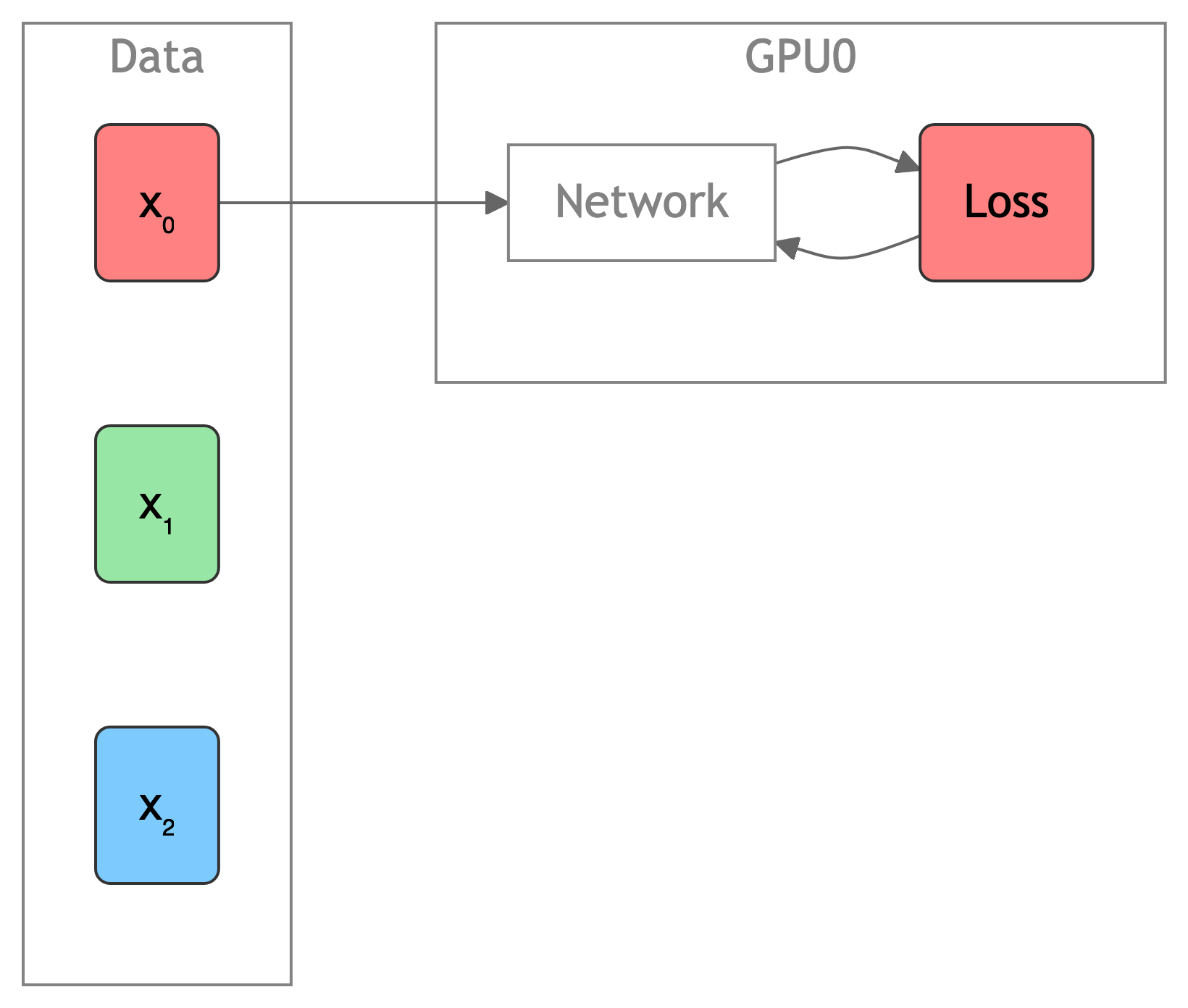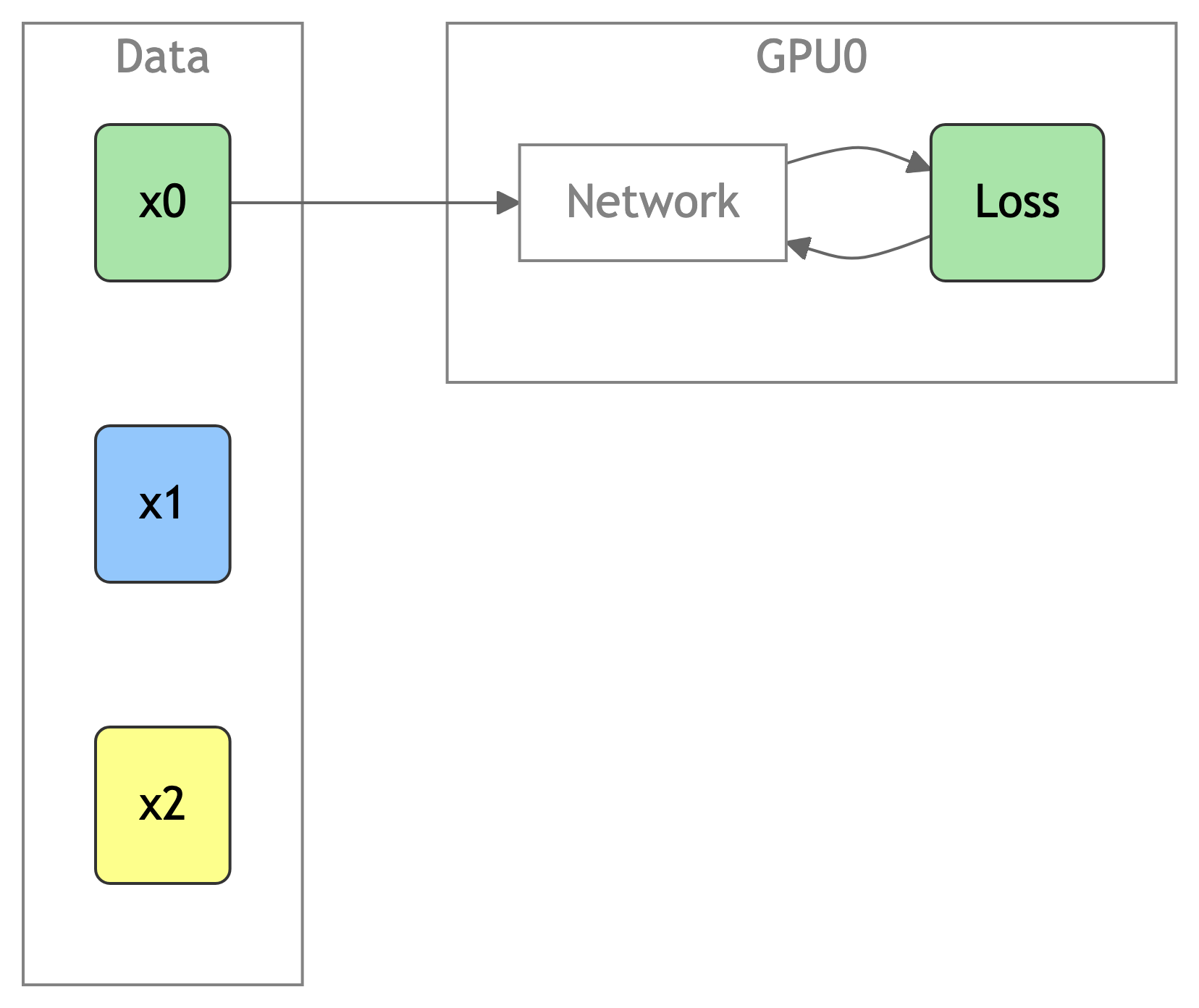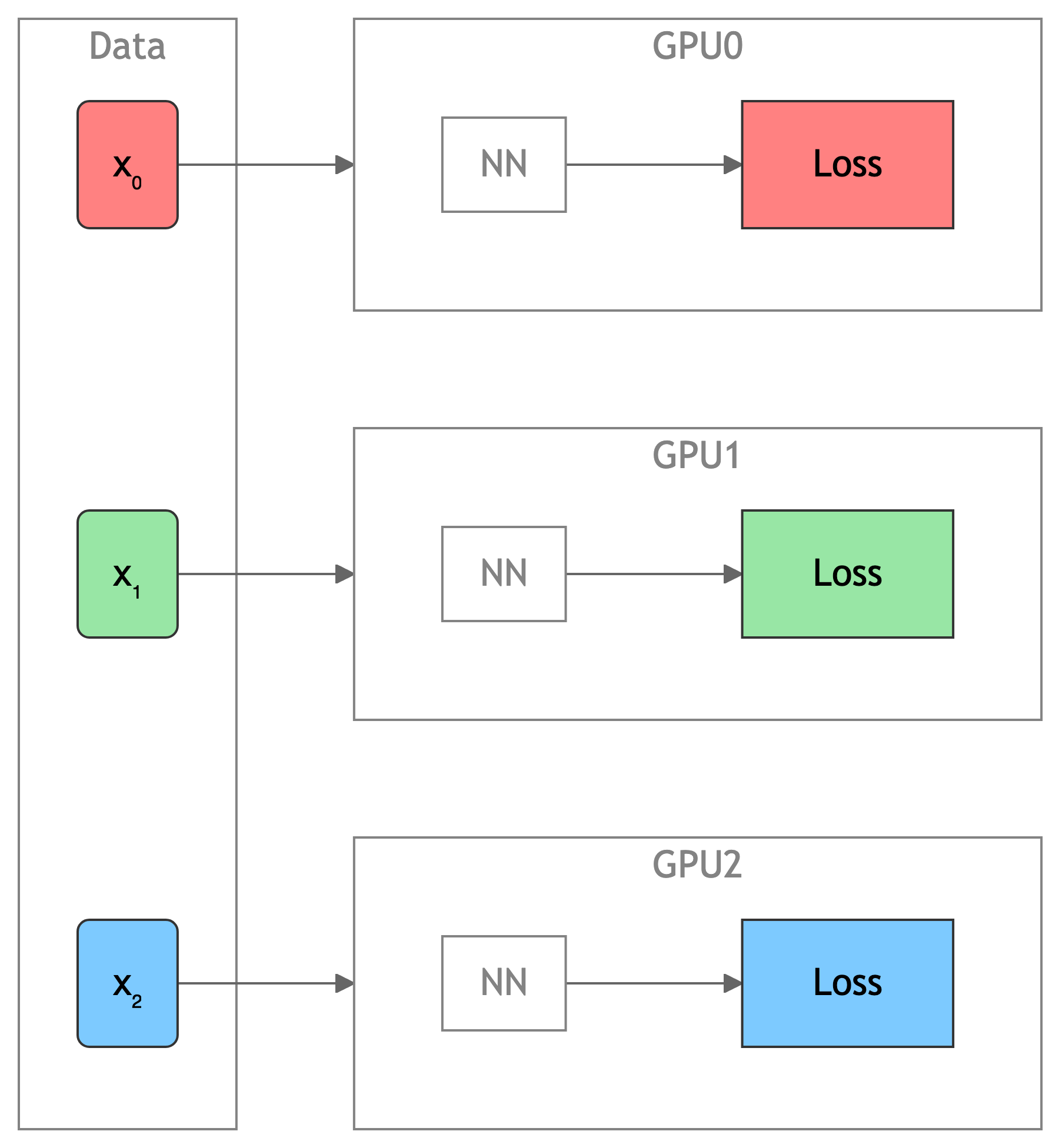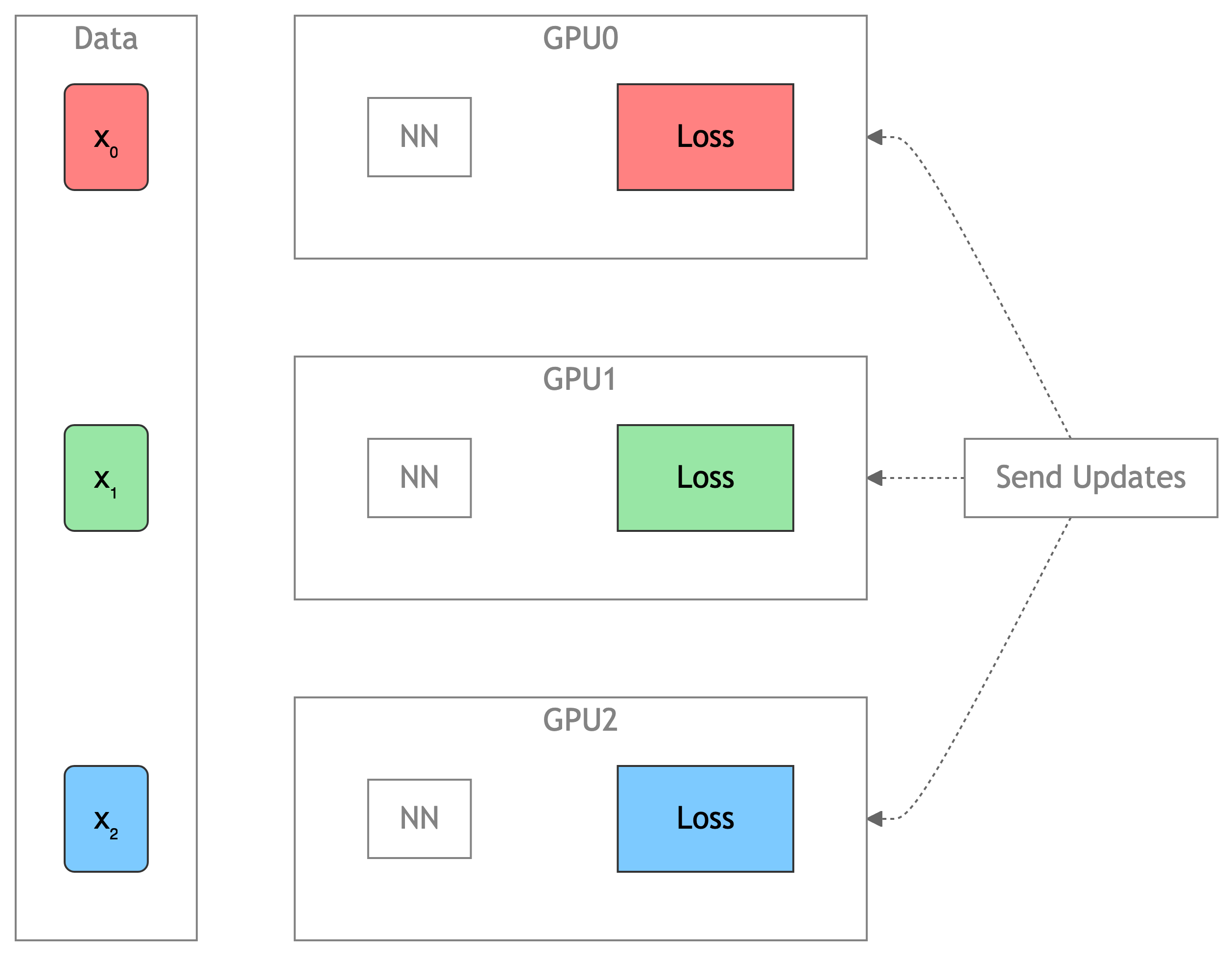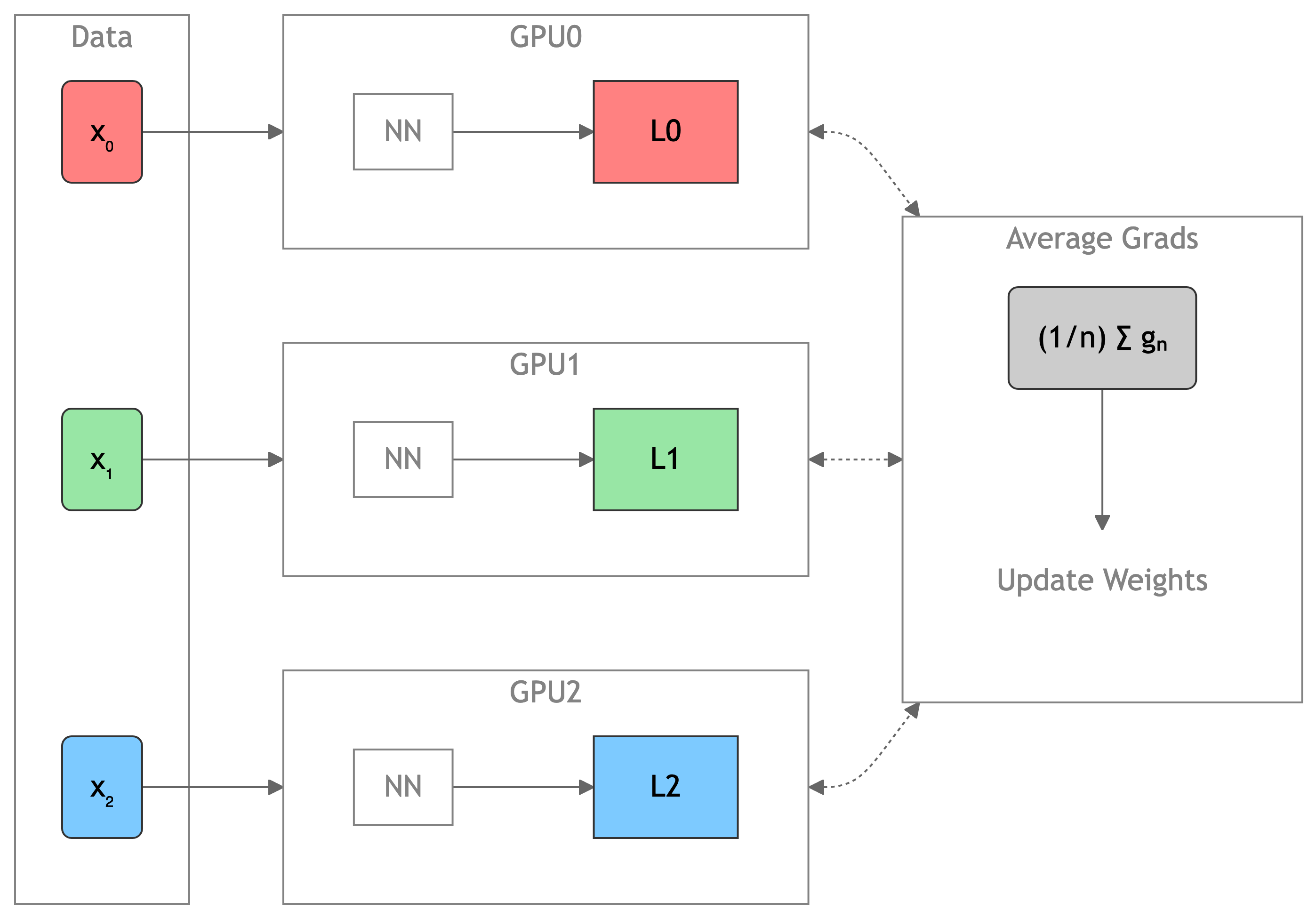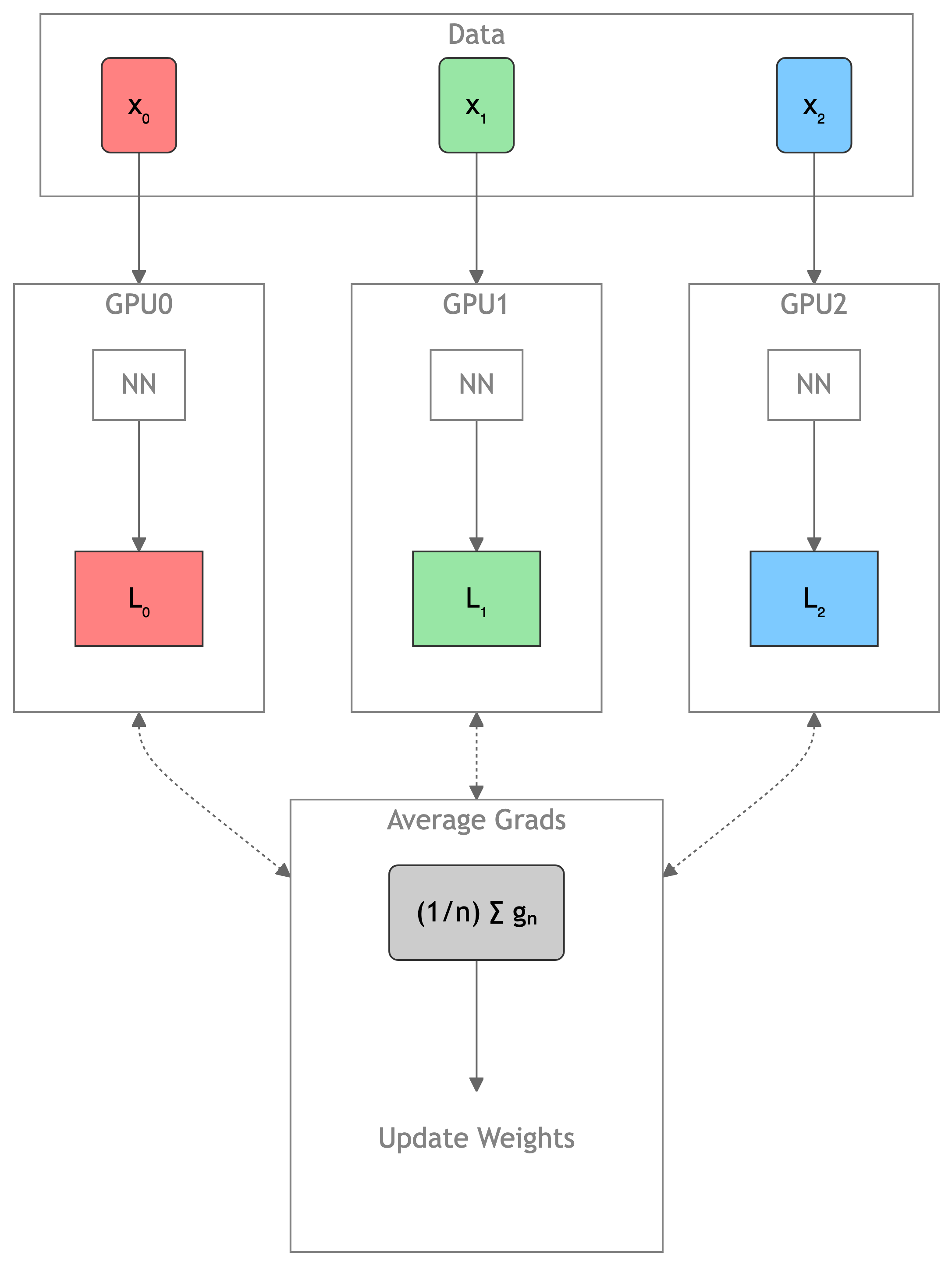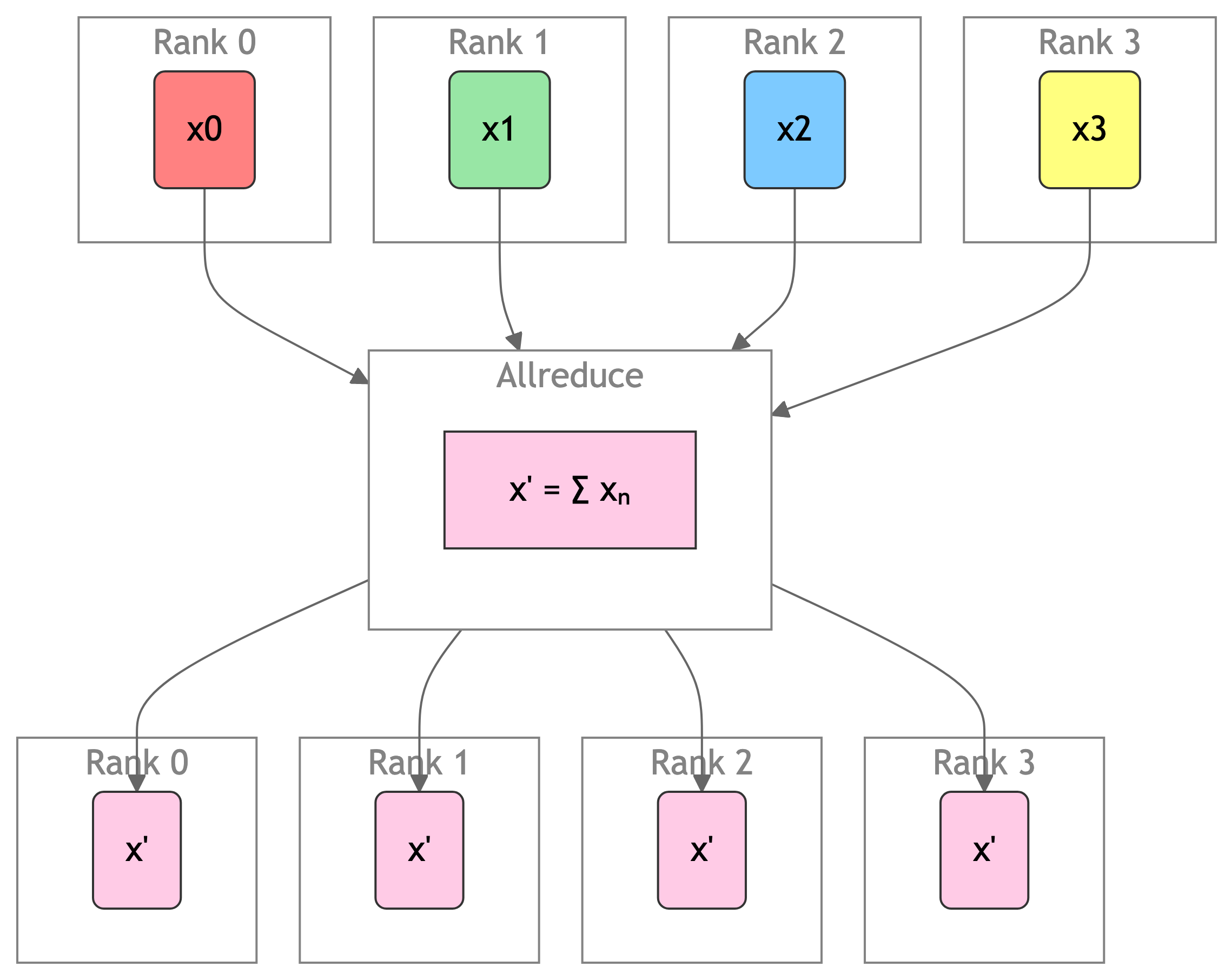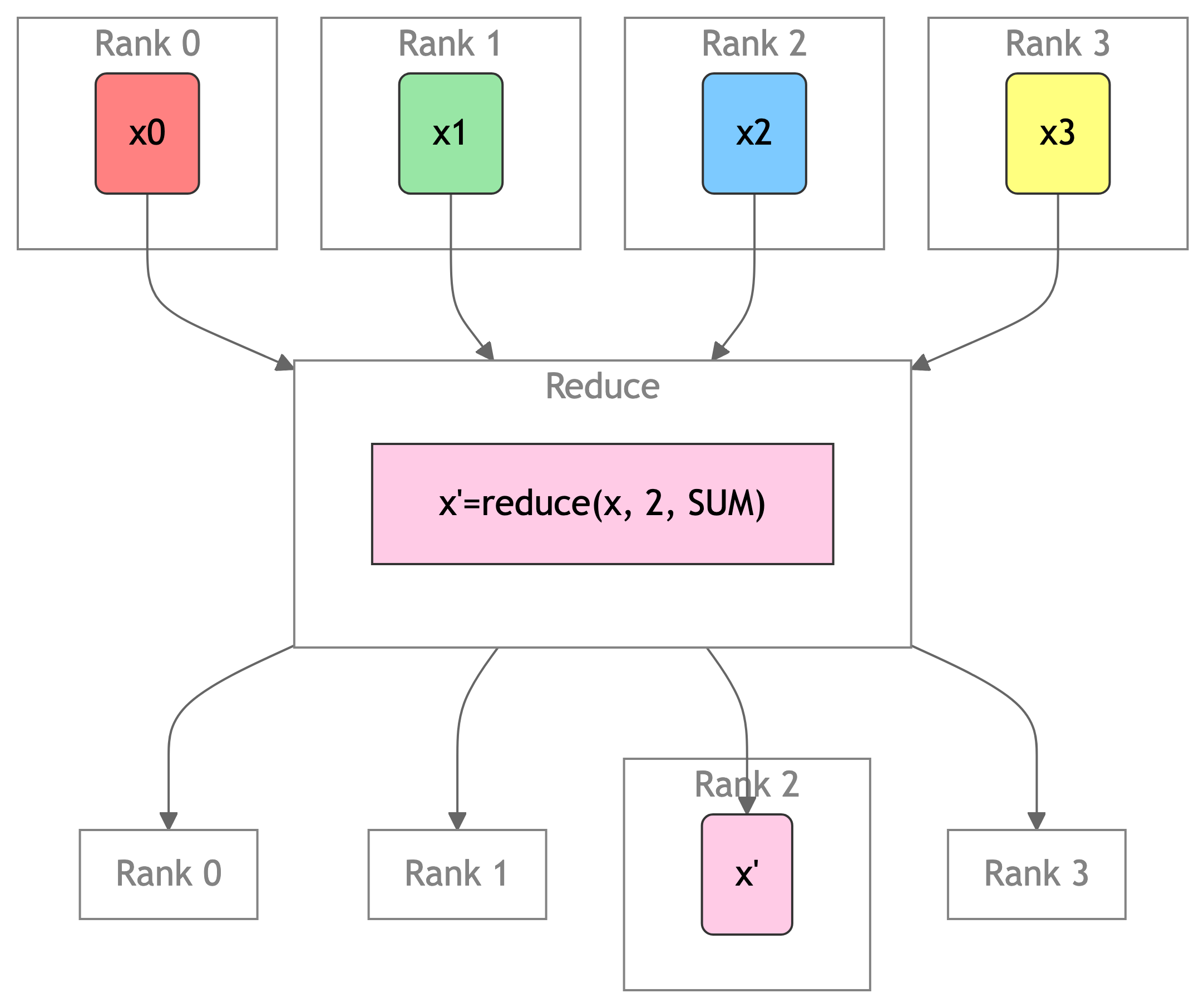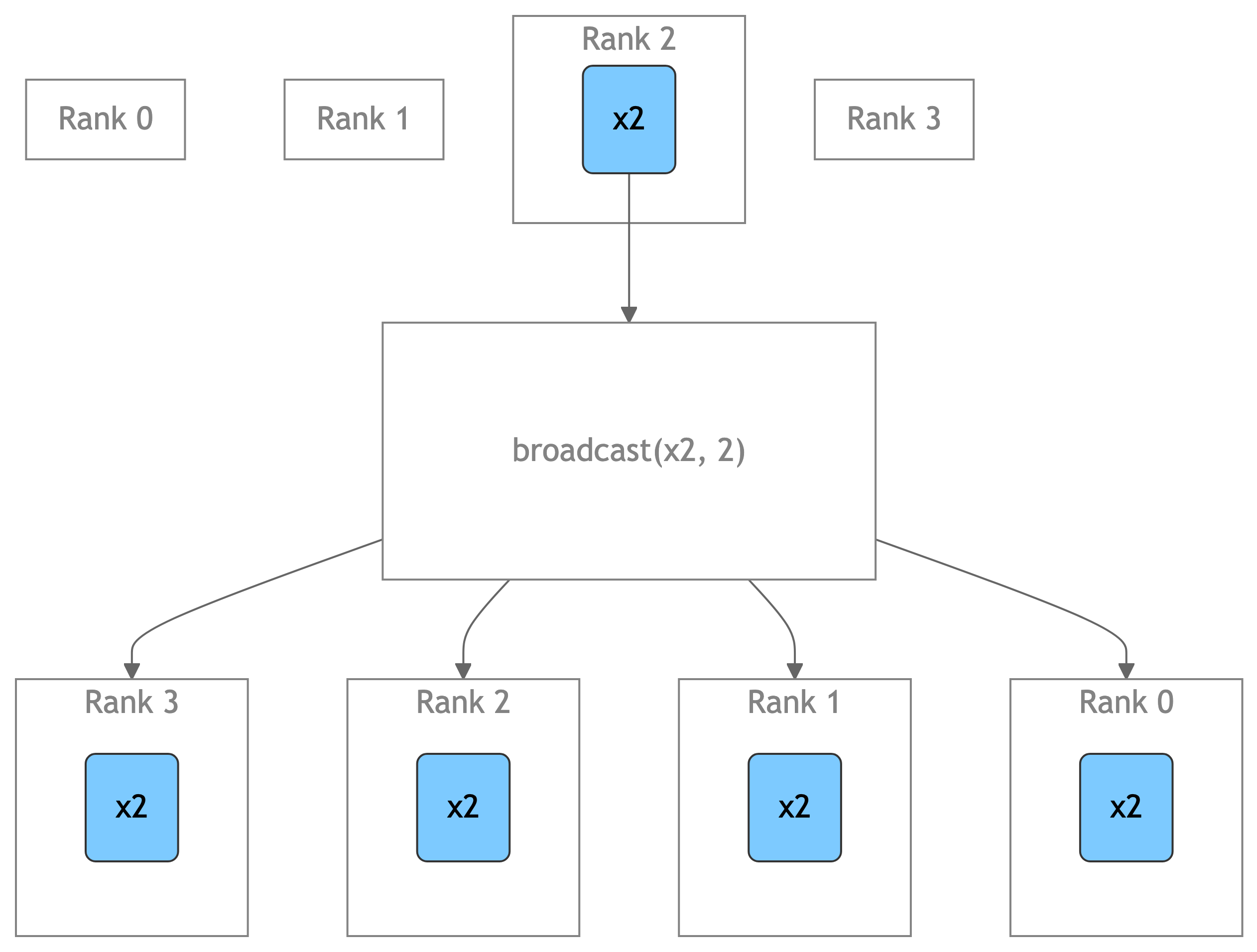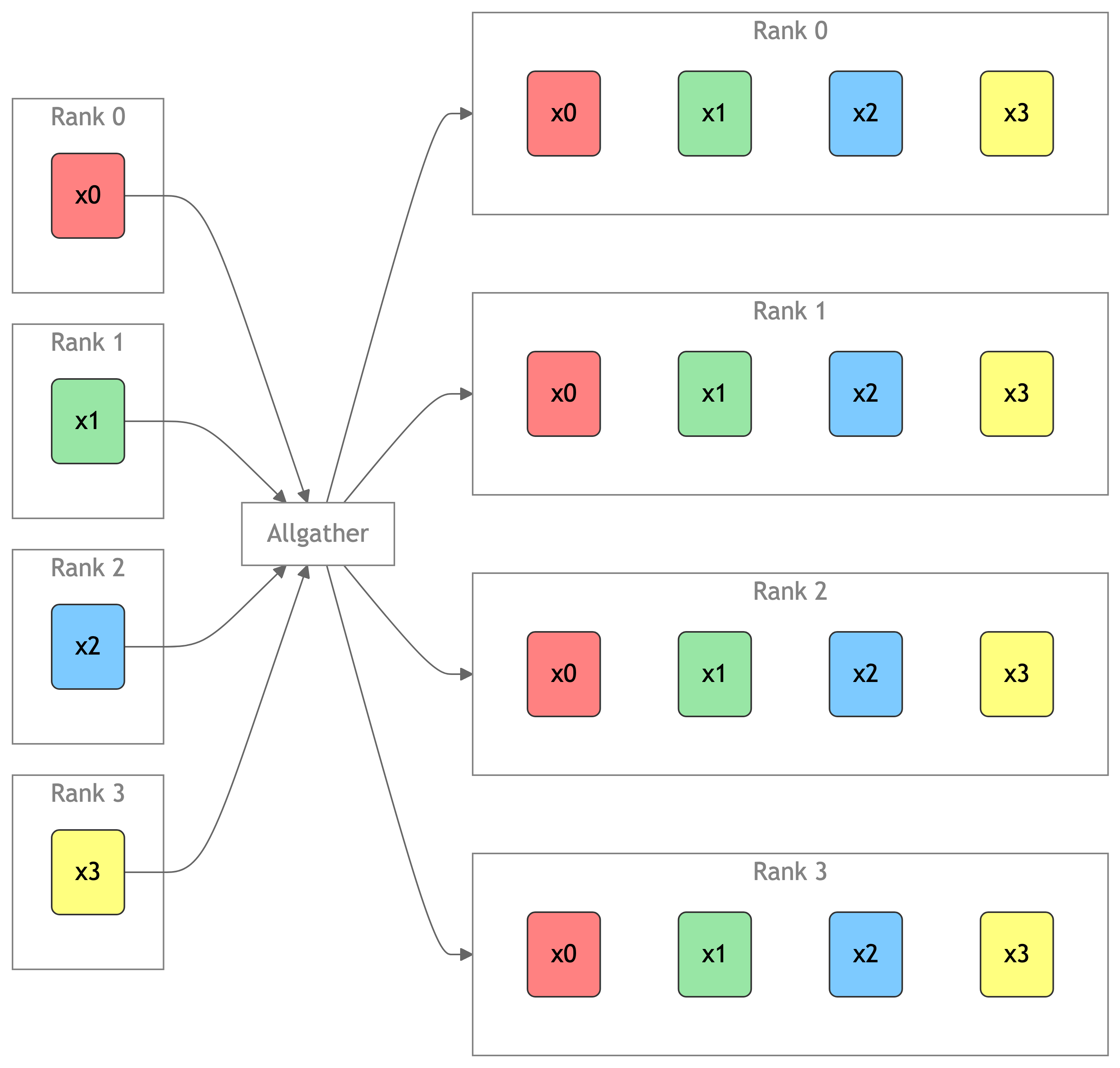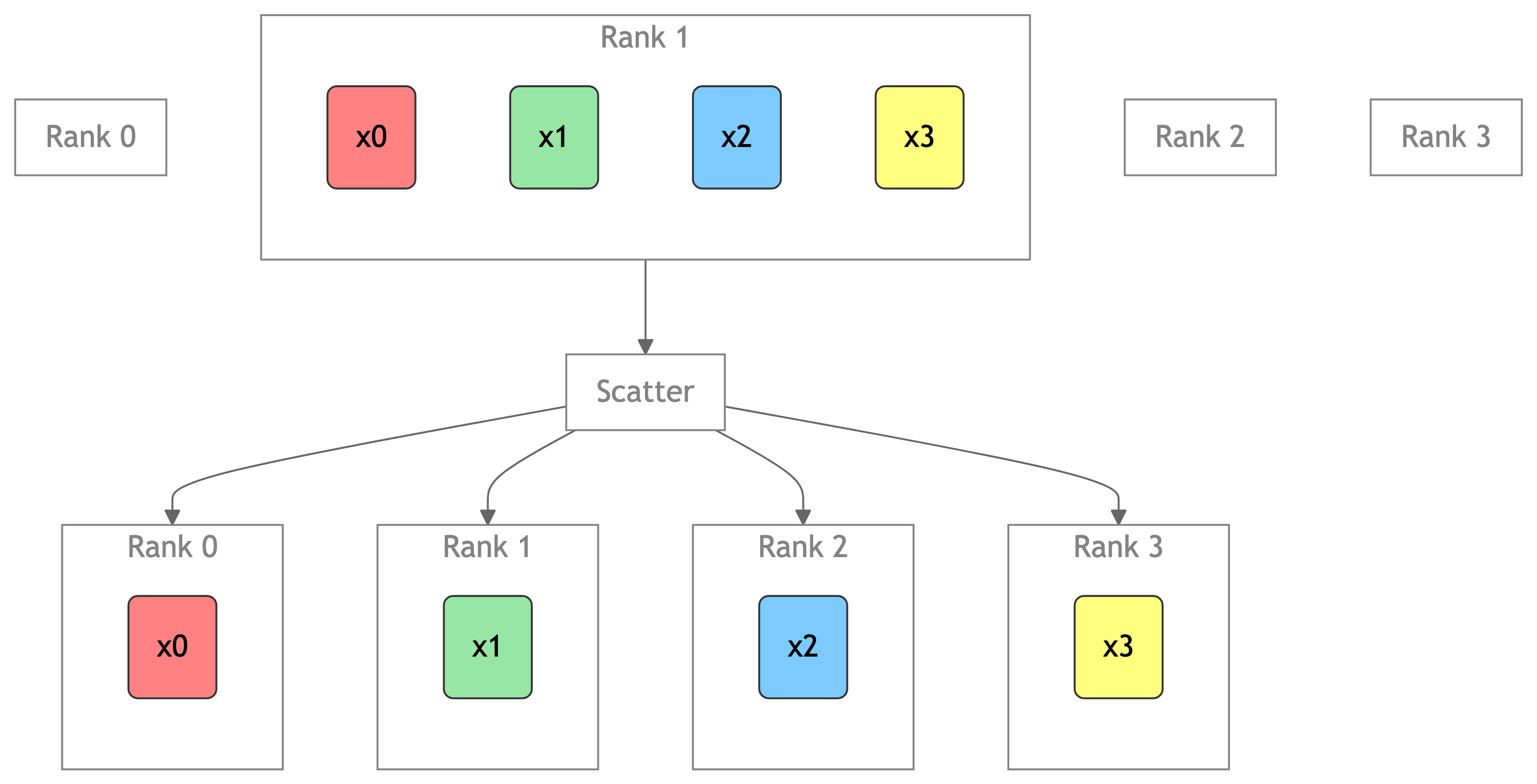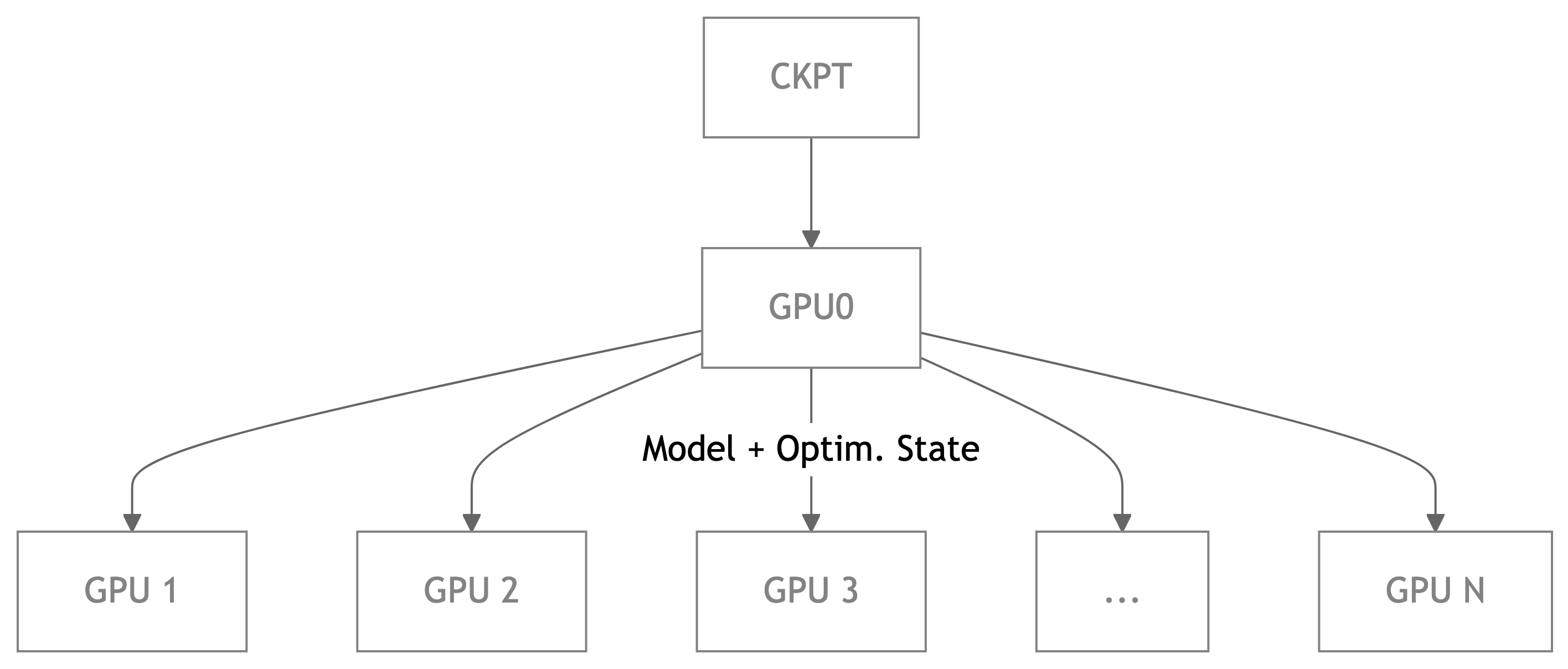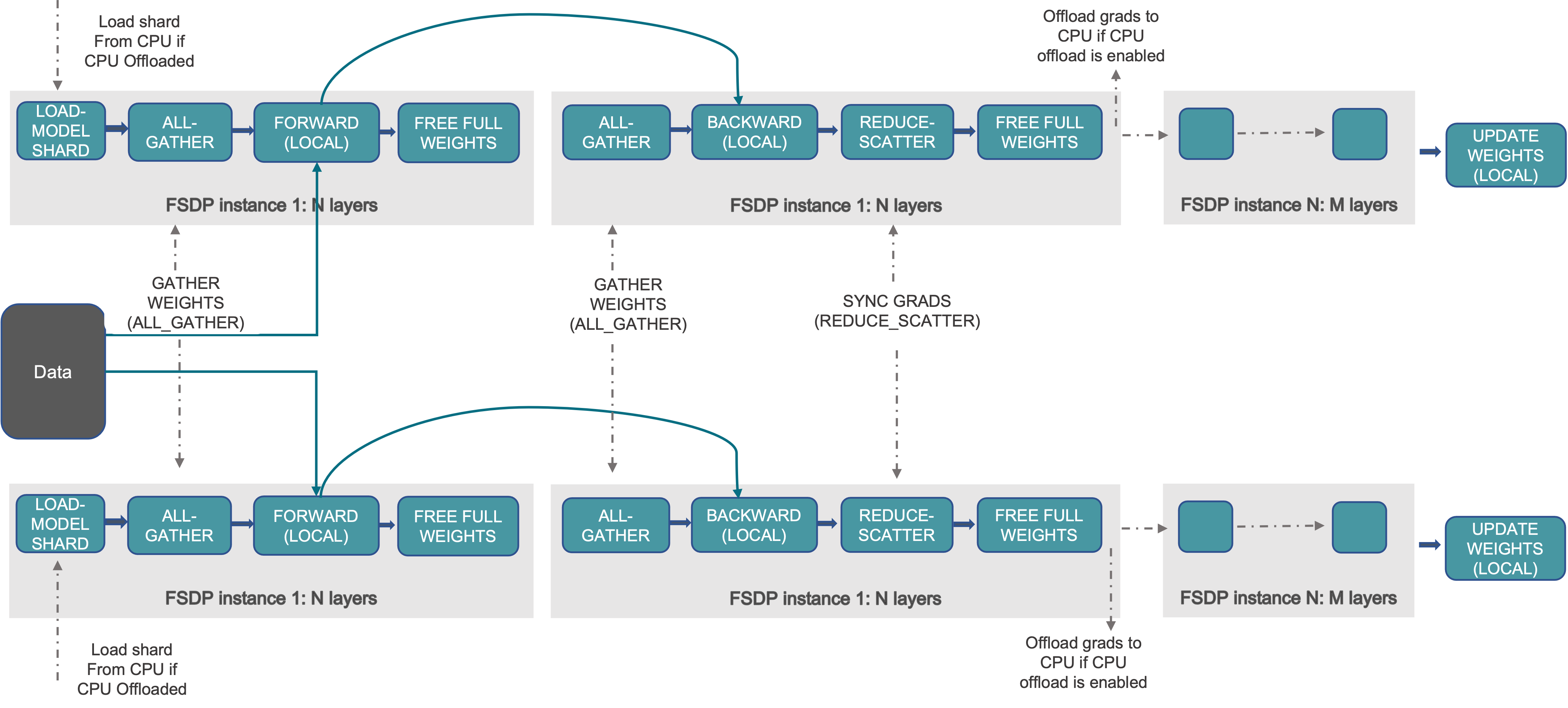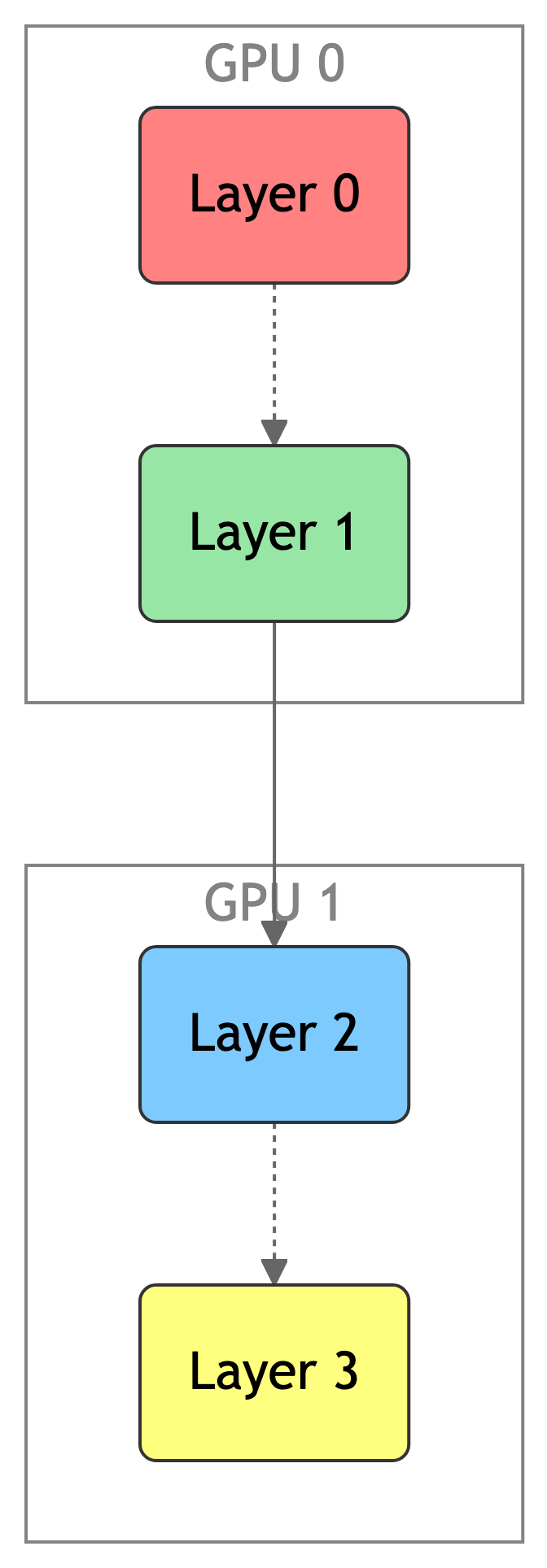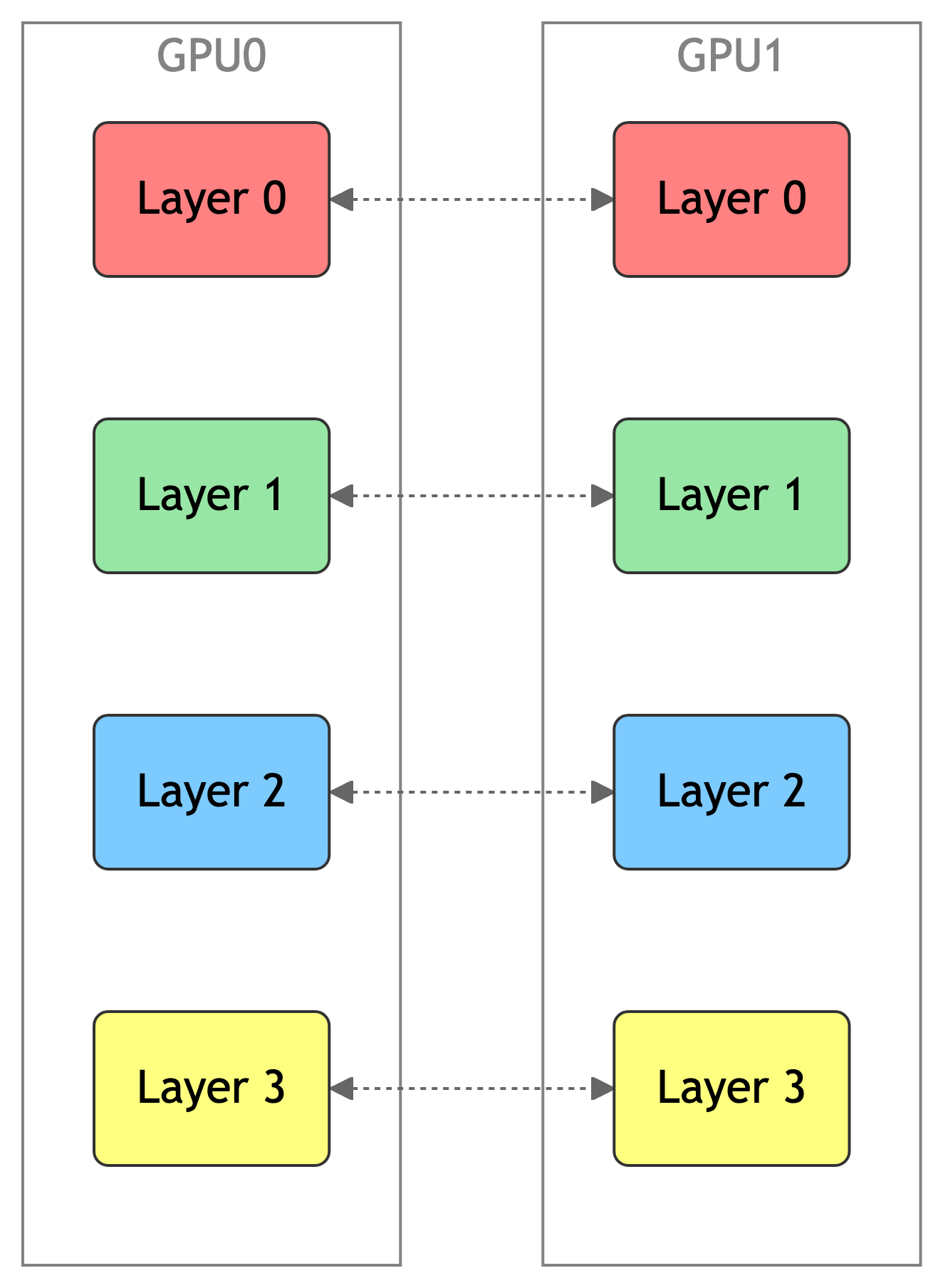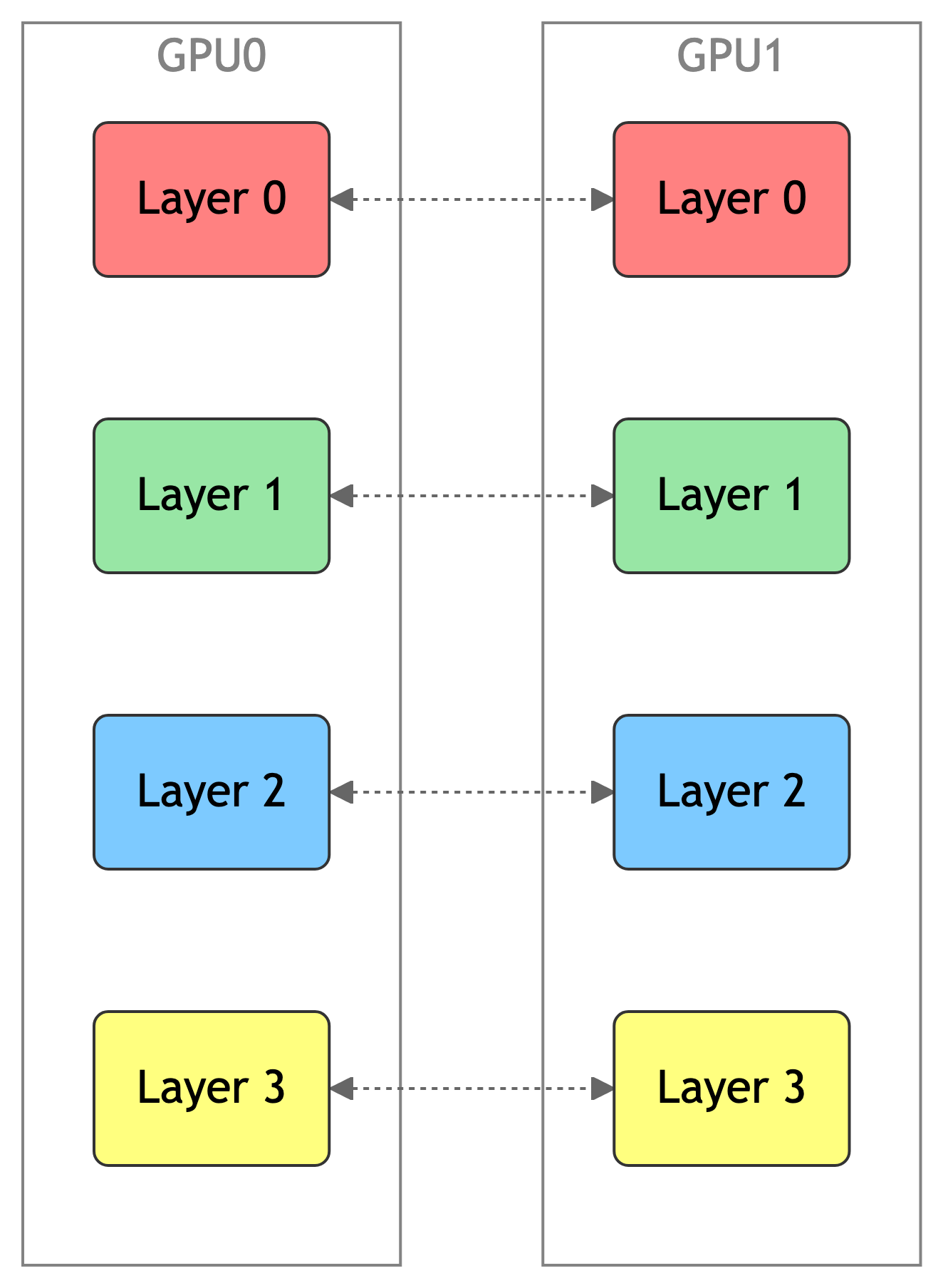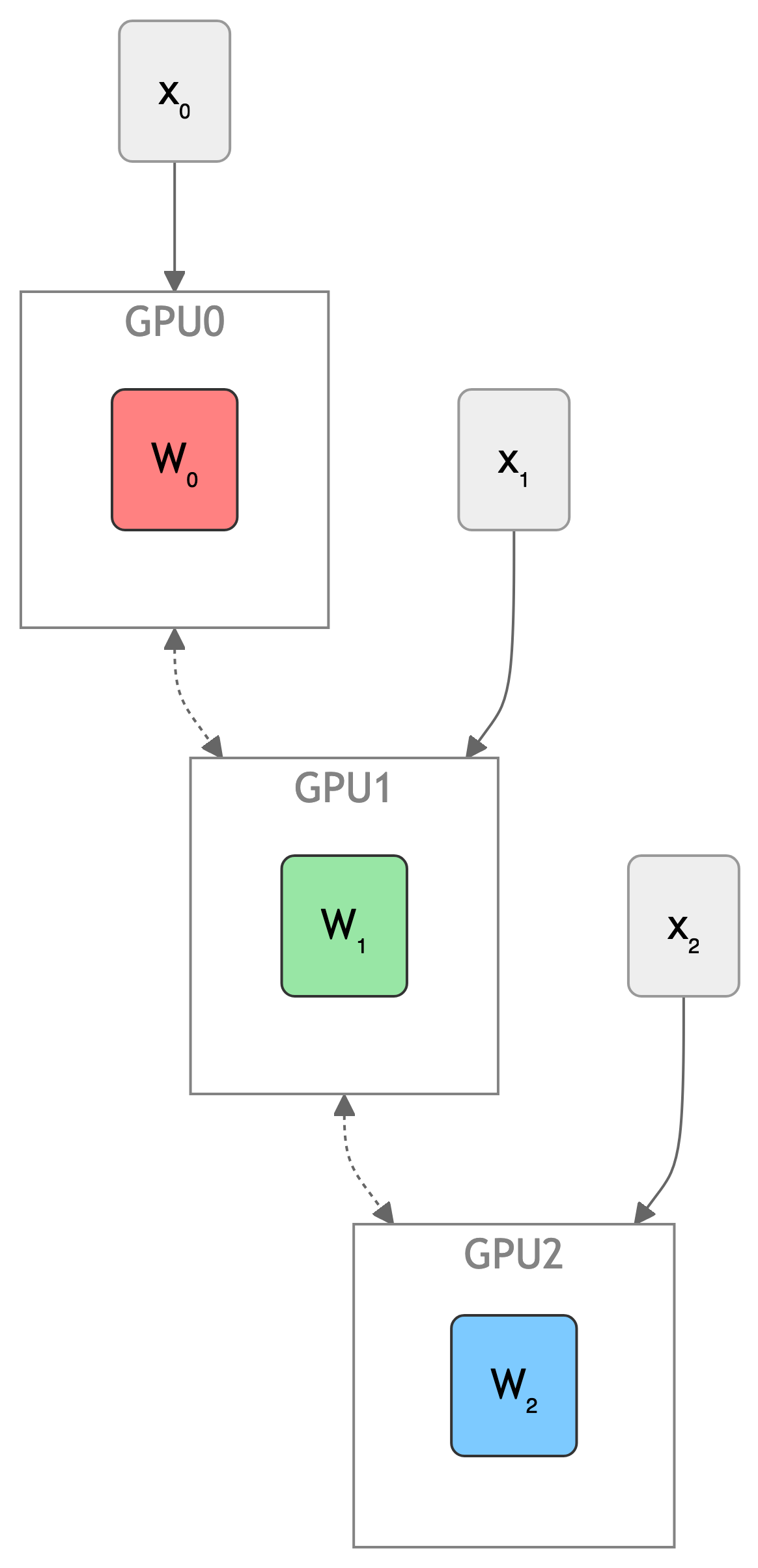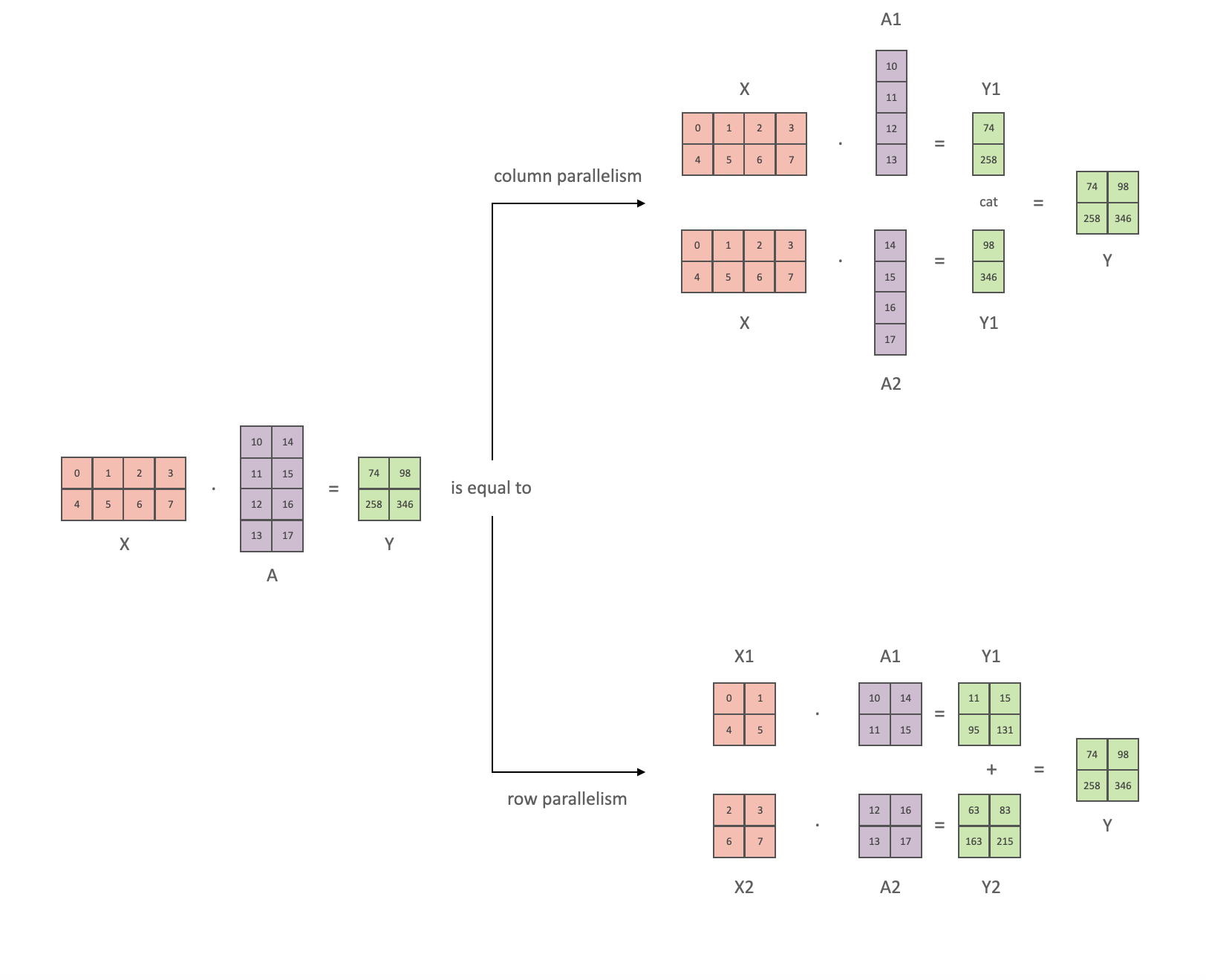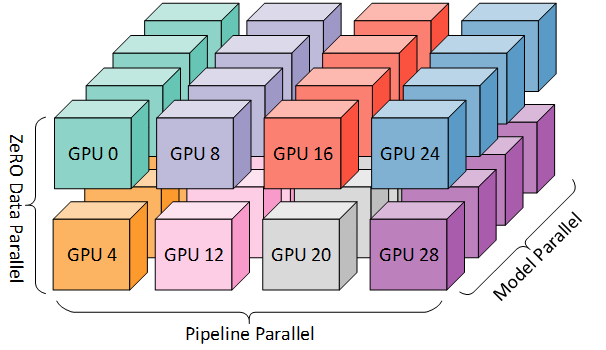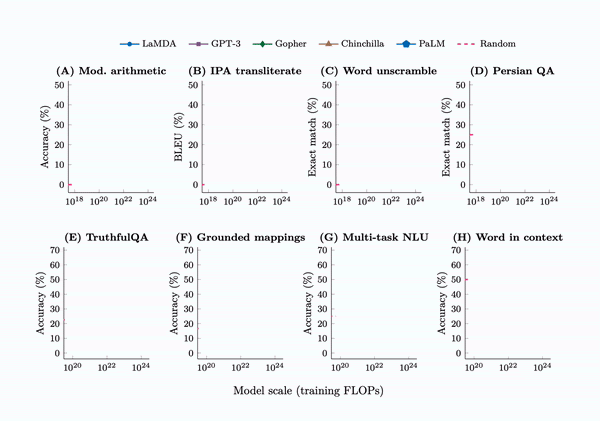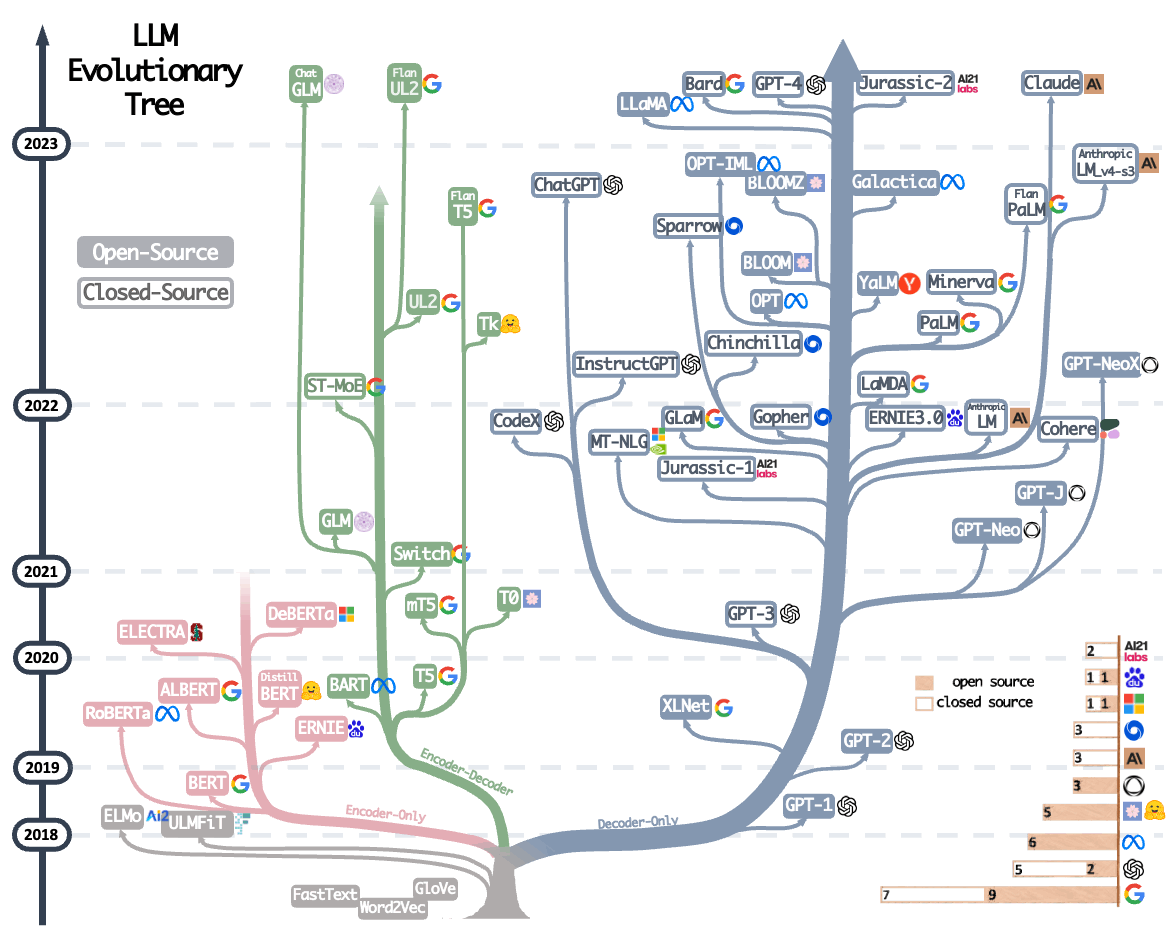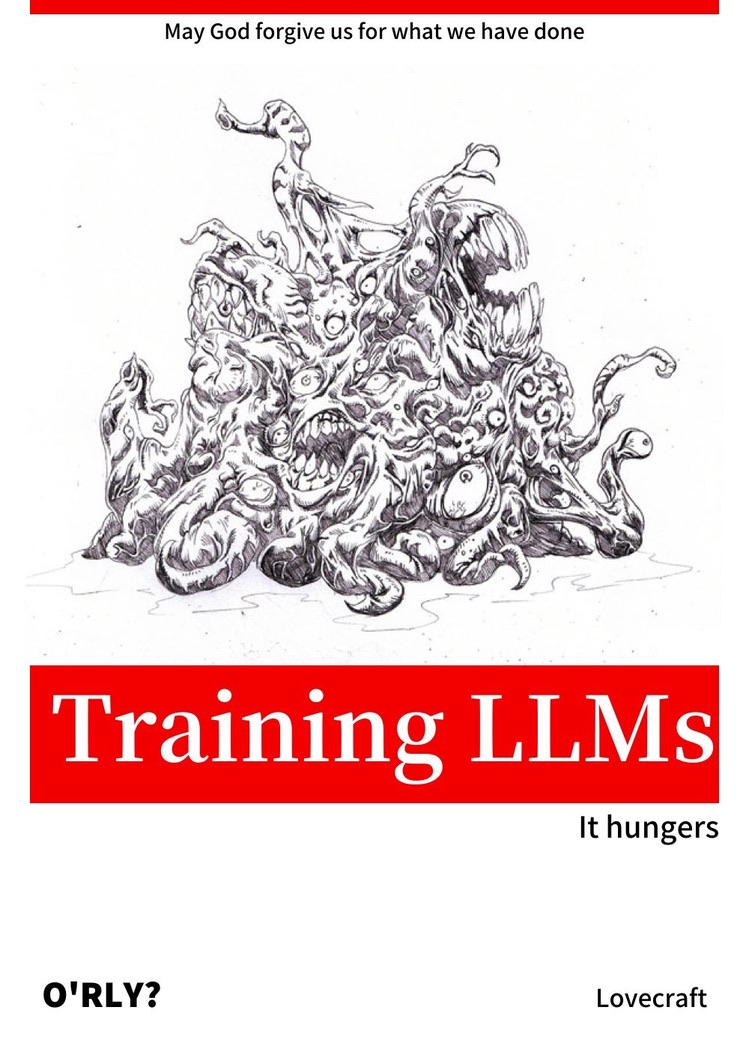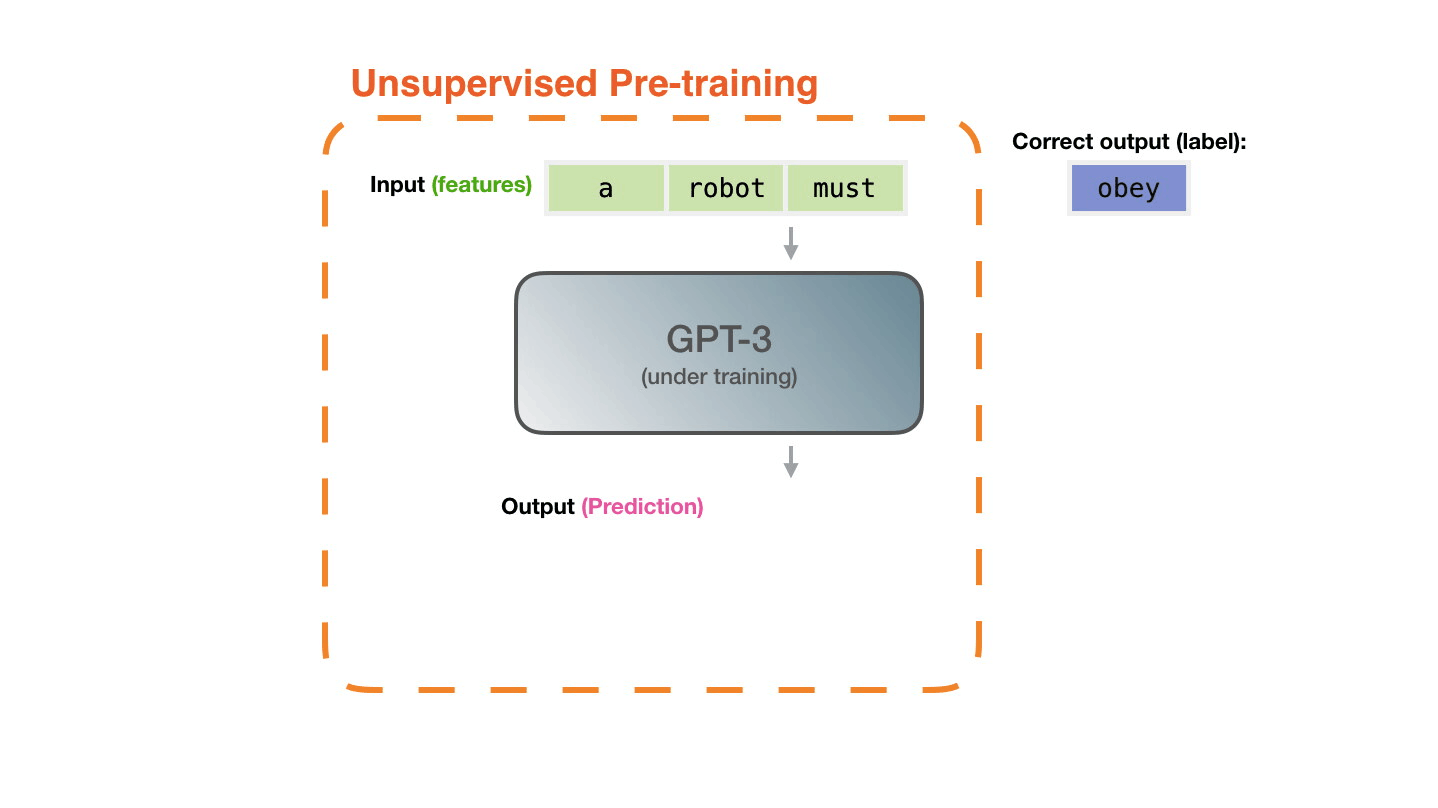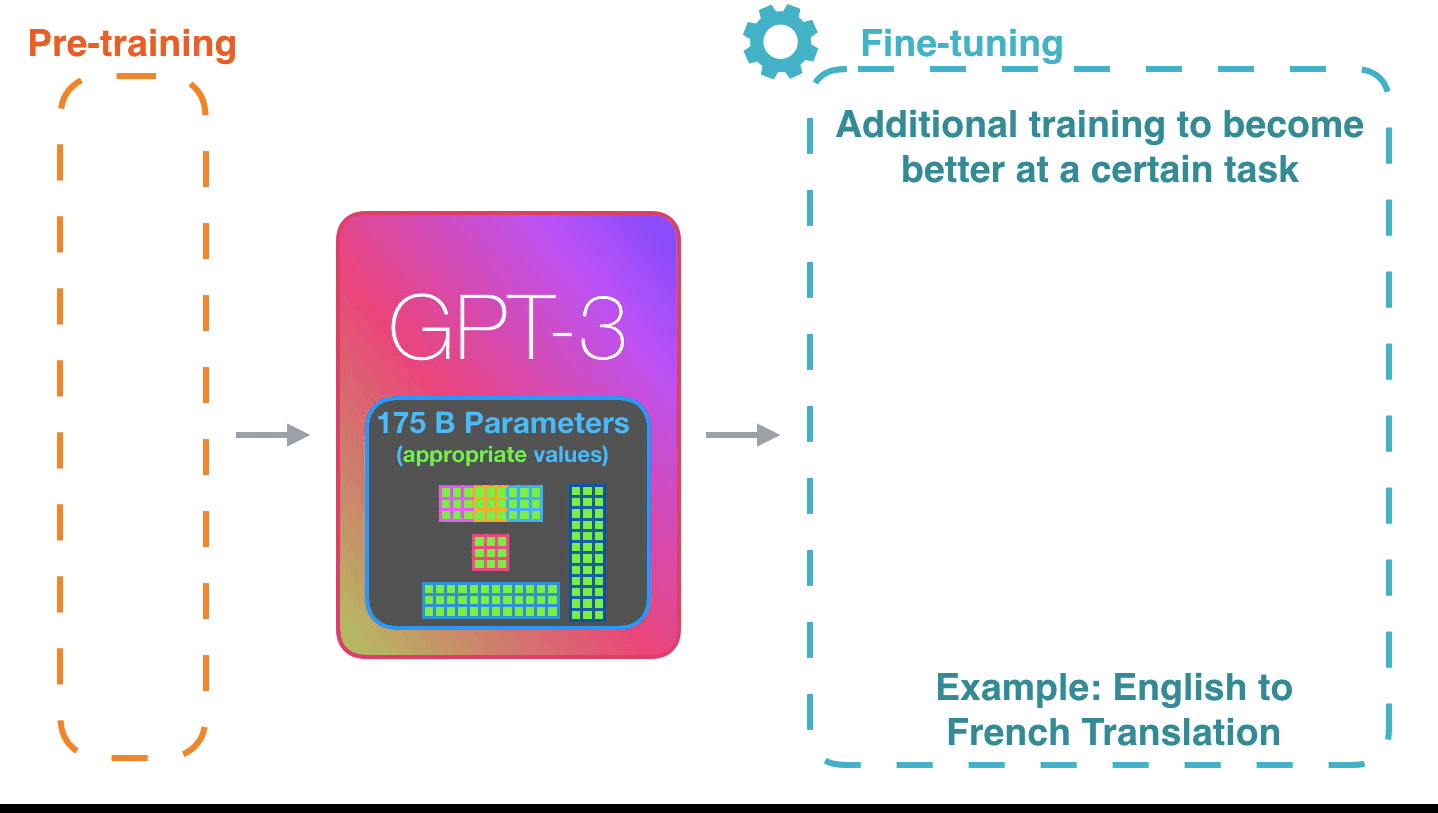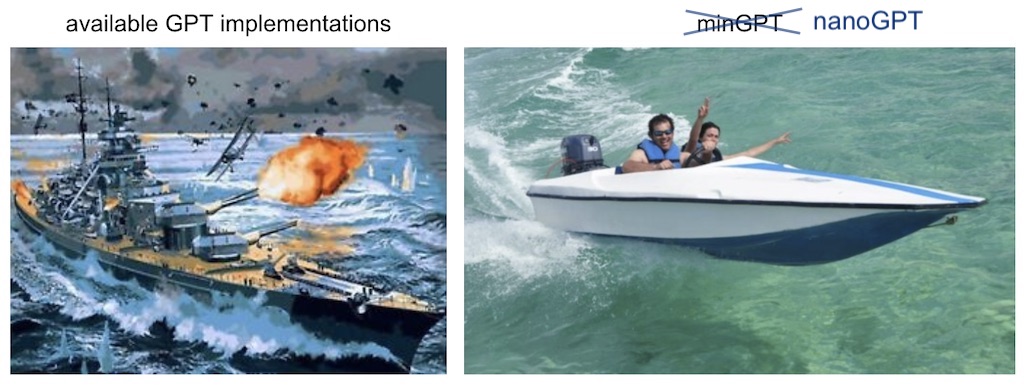👀 Overview
📑 Outline
🚀 Scaling: Overview
- ✅ Goal:
- Minimize: Cost (i.e. amount of time spent training)
- Maximize: Performance
📑 Note
See 🤗 Performance and Scalability for more details
🐢 Training on a Single Device
Single GPU
Single GPU
🏎️ Training on Multiple GPUs: Data Parallelism
Data Parallel: Forward Pass
Data Parallel: Backward Pass
Data Parallel: Full Setup
Data Parallel: Training
- Each GPU:
- has identical copy of model
- works on a unique subset of data
- Easy to get started (minor modifications to code):
- Requires global communication
- every rank must participate (collective communication) !!
🗣️ Communication
- Need mechanism(s) for communicating across GPUs:
- Collective Communication:
- Nvidia Collective Communications Library (NCCL)
- Intel oneAPI Collective Communications Library (oneCCL)
⌛ Timeouts
- Collective operations have to be called for each
rankto form a complete collective operation.- Failure to do so will result in other ranks waiting indefinitely
AllReduce
Perform reductions on data (e.g. sum, min, max) across ranks, send result back to everyone.
Reduce
- Perform a reduction on data across ranks, send to individual
Broadcast
AllGather
Scatter
Why Distributed Training?
Nworkers each processing unique batch1 of data:- [
micro_batch_size = 1] × [NGPUs] → [global_batch_size = N]
- [
- Improved gradient estimators
- Smooth loss landscape
- Less iterations needed for same number of epochs
- common to scale learning rate
lr *= sqrt(N)
- common to scale learning rate
- See: Large Batch Training of Convolutional Networks
Why Distributed Training? Speedup!
| Year | Author | GPU | Batch Size | # GPU | TIME (s) | ACC |
|---|---|---|---|---|---|---|
| 2016 | He | P100 | 256 | 8 | 104,400 | 75.30% |
| 2019 | Yamazaki | V100 | 81,920 | 2048 | 72 | 75.08% |
Dealing with Data
- At each training step, we want to ensure that each worker receives unique data
- This can be done in one of two ways:
- Manually partition data (ahead of time)
- Assign unique subsets to each worker
- Each worker can only see their local portion of the data
- Most common approach
- From each worker, randomly select a mini-batch
- Each worker can see the full dataset
- ⚠️ When randomly selecting, it is important that each worker uses different seeds to ensure they receive unique data
- Manually partition data (ahead of time)
Broadcast Initial State
- At the start of training (or when loading from a checkpoint), we want all of our workers to be initialized consistently
- Broadcast the model and optimizer states from
rank() == 0worker
- Broadcast the model and optimizer states from
Best Practices
⏰ Keeping things in Sync
Computation stalls during communication !!
Keeping the communication to computation ratio small is important for effective scaling.
- Use parallel IO whenever possible
- Feed each rank from different files
- Use MPI IO to have each rank read its own batch from a file
- Use several ranks to read data, MPI to scatter to remaining ranks
- Most practical in big at-scale training
- Take advantage of data storage
- Use the right optimizations for Aurora, Polaris, etc.
- Preload data when possible
- Offloading to a GPU frees CPU cycles for loading the next batch of data
- minimize IO latency this way
- Offloading to a GPU frees CPU cycles for loading the next batch of data
Going Beyond Data Parallelism
- ✅ Useful when model fits on single GPU:
- ultimately limited by GPU memory
- model performance limited by size
- ⚠️ When model does not fit on a single GPU:
- Offloading (can only get you so far…):
- Otherwise, resort to model parallelism strategies
Going beyond Data Parallelism: ZeRO
- Depending on the
ZeROstage (1, 2, 3), we can offload:- Stage 1: optimizer states (Pos)
- Stage 2: gradients + opt. states (Pos+g)
- Stage 3: model params + grads + opt. states (Pos+g+p)

Fully Sharded Data Parallel: 🔥 PyTorch + FSDP
- Instead of maintaining per-GPU copy of
{params, grads, opt_states}, FSDP shards (distributes) these across data-parallel workers- can optionally offload the sharded model params to CPU
- Introducing PyTorch Fully Sharded Data Parallel (FSDP) API | PyTorch
🕸️ Additional Parallelism Strategies
- Tensor (/ Model) Parallelism (
TP): - Pipeline Parallelism (
PP): - Sequence Parallelism (
SP): -
- Supports 4D Parallelism (
DP+TP+PP+SP)
- Supports 4D Parallelism (
Pipeline Parallelism (PP)
- Model is split up vertically (layer-level) across multiple GPUs
- Each GPU:
- has a portion of the full model
- processes in parallel different stages of the pipeline (on a small chunk of the batch)
- See:
Tensor Parallel (TP)
- Each tensor is split up into multiple chunks
- Each shard of the tensor resides on its designated GPU
- During processing each shard gets processed separately (and in parallel) on different GPUs
- synced at the end of the step
- See: 🤗 Model Parallelism for additional details
Tensor Parallel (TP)
- Suitable when the model is too large to fit onto a single device (CPU / GPU)
- Typically more complicated to implement than data parallel training
- This is what one may call horizontal parallelism
- Communication whenever dataflow between two subsets
-
argonne-lcf/Megatron-DeepSpeed - 🤗
huggingface/nanotron
Tensor (/ Model) Parallel Training: Example
Want to compute: y=∑ixiWi=x0∗W0+x1∗W1+x2∗W2
where each GPU only has only its portion of the full weights as shown below
- Compute: y0=x0∗W0→
GPU1 - Compute: y1=y0+x1∗W1→
GPU2 - Compute: y=y1+x2∗W2=∑ixiWi ✅
Tensor (Model) Parallelism1
- In Tensor Paralleism each GPU processes only a slice of a tensor and only aggregates the full tensor for operations that require the whole thing.
- The main building block of any transformer is a fully connected
nn.Linearfollowed by a nonlinear activation GeLU.Y = GeLU(XA), where X and Y are the input and output vectors, and A is the weight matrix.
- If we look at the computation in matrix form, it’s easy to see how the matrix multiplication can be split between multiple GPUs:
- The main building block of any transformer is a fully connected
Tensor Parallelism
3D Parallelism
DP+TP+PP(3D) Parallelism
Deciding on a Parallelism Strategy
- Model fits onto a single GPU:
- Normal use
- Model DOES NOT fit on a single GPU:
ZeRO+ Offload CPU (or, optionally,NVMe)
- Largest layer DOES NOT fit on a single GPU:
ZeRO+ Enable Memory Centric Tiling (MCT)- MCT Allows running of arbitrarily large layers by automatically splitting them and executing them sequentially.
- Model DOES NOT fit onto a single GPU
- With sufficiently fast connectivity between nodes, these three strategies should be comparable.
- Otherwise,
PP>ZeRO≃TP.
- Otherwise,
When you have fast inter-node connectivity:
ZeRO(virtually NO modifications)PP+ZeRO+TP+DP(less communication, at the cost of MAJOR modifications)when you have slow inter-node connectivity and still low on GPU memory:
- NOTE:
TPis almost always used within a single node, e.g.
TP <= GPUS_PER_NODE
🦙 Large Language Models
🔮 Emergent Abilities
🚂 Training LLMs
♻️ Life-Cycle of the LLM
🎀 Life-Cycle of the LLM
⏩ Forward Pass
💬 Generating Text
👋 Hands On
🧑💻 Hands On: Getting Started
🌱 Clone Repo(s):
🐍 Setup Python:
📦 Install {ezpz, wordplay}
Install Python packages:
Test distributed setup:
See: 🍋
ezpz/test_dist.py
ezpz: Example [video]
ezpz.test_dist to train a small model using DDP
Install wordplay 🎮💬
nanoGPT
Prepare Data
$ python3 wordplay/data/shakespeare_char/prepare.py
Using HF_DATASETS_CACHE=/home/foremans/tmp/polaris-talk/2024-07-17-073327/wordplay/data/shakespeare_char/.cache/huggingface
length of dataset in characters: 1,115,394
all the unique characters:
!$&\',-.3:;?ABCDEFGHIJKLMNOPQRSTUVWXYZabcdefghijklmnopqrstuvwxyz
vocab size: 65
train has 1,003,854 tokens
val has 111,540 tokensLaunch Training (DDP)
Training: Example Output
$ launch python3 -m wordplay \
train.backend=DDP \
train.eval_interval=100 \
data=shakespeare \
train.dtype=bf16 \
model.batch_size=64 \
model.block_size=1024 \
train.max_iters=1000 \
train.log_interval=10 \
train.compile=false \
| tee wordplay-gpt2-DDP.log
[2024-07-17 07:42:11.746540][INFO][__init__:156] - Setting logging level to 'INFO' on 'RANK == 0'
[2024-07-17 07:42:11.748763][INFO][__init__:157] - Setting logging level to 'CRITICAL' on all others 'RANK != 0'
[2024-07-17 07:42:11.749453][INFO][__init__:160] - To disable this behavior, and log from ALL ranks (not recommended), set: 'export LOG_FROM_ALL_RANKS=1' in your environment, and re-run.
[2024-07-17 07:42:11.772718][INFO][configs:81] - Setting HF_DATASETS_CACHE to /home/foremans/tmp/polaris-talk/2024-07-17-073327/wordplay/.cache/huggingface/datasets
[2024-07-17 07:42:15.341532][INFO][dist:358] - [device='cuda'][rank=2/3][local_rank=2/3][node=0/0]
[2024-07-17 07:42:15.342381][INFO][dist:358] - [device='cuda'][rank=1/3][local_rank=1/3][node=0/0]
[2024-07-17 07:42:15.342430][INFO][dist:358] - [device='cuda'][rank=3/3][local_rank=3/3][node=0/0]
[2024-07-17 07:42:15.348657][INFO][dist:95] -
[dist_info]:
• DEVICE=cuda
• DEVICE_ID=cuda:0
• DISTRIBUTED_BACKEND=nccl
• GPUS_PER_NODE=4
• HOSTS=['x3101c0s13b0n0.hsn.cm.polaris.alcf.anl.gov']
• HOSTFILE=/var/spool/pbs/aux/2024084.polaris-pbs-01.hsn.cm.polaris.alcf.anl.gov
• HOSTNAME=x3101c0s13b0n0.hsn.cm.polaris.alcf.anl.gov
• LOCAL_RANK=0
• MACHINE=Polaris
• NUM_NODES=1
• NGPUS=4
• NGPUS_AVAILABLE=4
• NODE_ID=0
• RANK=0
• SCHEDULER=PBS
• WORLD_SIZE_TOTAL=4
• WORLD_SIZE_IN_USE=4
• LAUNCH_CMD=mpiexec --verbose --envall -n 4 -ppn 4 --hostfile /var/spool/pbs/aux/2024084.polaris-pbs-01.hsn.cm.polaris.alcf.anl.gov --cpu-bind depth -d 16
[2024-07-17 07:42:15.351446][INFO][dist:725] - [0/4] Using device='cuda' with backend='DDP' + 'nccl' for distributed training.
[2024-07-17 07:42:15.356169][INFO][dist:358] - [device='cuda'][rank=0/3][local_rank=0/3][node=0/0]
[2024-07-17 07:42:15.356692][WARNING][dist:364] - Using [4 / 4] available "cuda" devices !!
[2024-07-17 07:42:15.359571][INFO][configs:317] - Loading val from /home/foremans/tmp/polaris-talk/2024-07-17-073327/wordplay/data/shakespeare_char/val.bin
[2024-07-17 07:42:15.360138][INFO][configs:317] - Loading train from /home/foremans/tmp/polaris-talk/2024-07-17-073327/wordplay/data/shakespeare_char/train.bin
[2024-07-17 07:42:15.361154][INFO][configs:442] - Tokens per iteration: 262,144
[2024-07-17 07:42:15.361574][INFO][configs:465] - Using self.ptdtype=torch.float16 on self.device_type='cuda'
[2024-07-17 07:42:15.362002][INFO][configs:471] - Initializing a new model from scratch
[2024-07-17 07:42:15.362529][INFO][dist:874] - Setting up wandb from rank: 0
[2024-07-17 07:42:15.362896][INFO][dist:875] - Using: WB PROJECT: WordPlay
[2024-07-17 07:42:16.451786][INFO][dist:905] - W&B RUN: [still-frog-17](https://wandb.ai/aurora_gpt/WordPlay/runs/6by9vpcj)
[2024-07-17 07:42:16.464106][INFO][dist:312] - Updating wandb.run: still-frog-17 config with "DIST_INFO"
[2024-07-17 07:42:16.469424][INFO][dist:938] - Running on machine='Polaris'
[2024-07-17 07:42:16.471151][WARNING][__main__:89] - {
"train": {
"framework": "pytorch",
"backend": "DDP",
"device": null,
"seed": null,
"port": null,
"ds_config_path": null,
"precision": null,
"ngpus": null,
"use_wandb": true,
"eval_interval": 100,
"log_interval": 10,
"eval_iters": 200,
"eval_only": false,
"always_save_checkpoint": false,
"init_from": "scratch",
"wandb_project": "WordPlay",
"max_iters": 1000,
"warmup_iters": 100,
"dtype": "bf16",
"compile": false
},
"model": {
"n_layer": 12,
"n_head": 12,
"n_embd": 768,
"batch_size": 64,
"block_size": 1024,
"activation": "gelu",
"dropout": 0.0,
"bias": false,
"vocab_size": 65
},
"data": {
"dataset": "shakespeare_char",
"out_dir": "out-shakespeare-char",
"root_path": null
},
"optimizer": {
"gas": 1,
"name": "AdamW",
"learning_rate": 0.0006,
"weight_decay": 0.1,
"beta1": 0.9,
"beta2": 0.95,
"grad_clip": 1.0,
"decay_lr": true,
"lr_decay_iters": 600000,
"min_lr": 6e-05
}
}
[2024-07-17 07:42:16.474305][WARNING][__main__:90] - Output dir: /home/foremans/tmp/polaris-talk/outputs/runs/pytorch/DDP/2024-07-17/07-42-13
[2024-07-17 07:42:16.474922][INFO][trainer:246] - Initializing a new model from scratch
[2024-07-17 07:42:17.258904][INFO][model:255] - number of parameters: 85.00M
[2024-07-17 07:42:17.290004][INFO][trainer:264] - Model size: num_params=85003776
[2024-07-17 07:42:17.292626][INFO][model:445] - num decayed parameter tensors: 50, with 85,771,008 parameters
[2024-07-17 07:42:17.293296][INFO][model:449] - num non-decayed parameter tensors: 25, with 19,200 parameters
[2024-07-17 07:42:17.515324][CRITICAL][trainer:316] - "devid='cuda:1'"
[2024-07-17 07:42:17.515340][CRITICAL][trainer:316] - "devid='cuda:2'"
[2024-07-17 07:42:17.515465][CRITICAL][trainer:316] - "devid='cuda:3'"
[2024-07-17 07:42:18.431814][INFO][model:465] - using fused AdamW: True
[2024-07-17 07:42:18.432620][CRITICAL][trainer:316] - "devid='cuda:0'"
[2024-07-17 07:42:19.951020][INFO][trainer:356] - • self.model=GPT(
(transformer): ModuleDict(
(wte): Embedding(65, 768)
(wpe): Embedding(1024, 768)
(drop): Dropout(p=0.0, inplace=False)
(h): ModuleList(
(0-11): 12 x Block(
(ln_1): LayerNorm()
(attn): CausalSelfAttention(
(c_attn): Linear(in_features=768, out_features=2304, bias=False)
(c_proj): Linear(in_features=768, out_features=768, bias=False)
(attn_dropout): Dropout(p=0.0, inplace=False)
(resid_dropout): Dropout(p=0.0, inplace=False)
)
(ln_2): LayerNorm()
(mlp): MLP(
(c_fc): Linear(in_features=768, out_features=3072, bias=False)
(act_fn): GELU(approximate='none')
(c_proj): Linear(in_features=3072, out_features=768, bias=False)
(dropout): Dropout(p=0.0, inplace=False)
)
)
)
(ln_f): LayerNorm()
)
(lm_head): Linear(in_features=768, out_features=65, bias=False)
)
[2024-07-17 07:42:19.955340][INFO][trainer:357] - • self.grad_scaler=<torch.cuda.amp.grad_scaler.GradScaler object at 0x145a38f0f090>
[2024-07-17 07:42:19.956897][INFO][trainer:358] - • self.model_engine=DistributedDataParallel(
(module): GPT(
(transformer): ModuleDict(
(wte): Embedding(65, 768)
(wpe): Embedding(1024, 768)
(drop): Dropout(p=0.0, inplace=False)
(h): ModuleList(
(0-11): 12 x Block(
(ln_1): LayerNorm()
(attn): CausalSelfAttention(
(c_attn): Linear(in_features=768, out_features=2304, bias=False)
(c_proj): Linear(in_features=768, out_features=768, bias=False)
(attn_dropout): Dropout(p=0.0, inplace=False)
(resid_dropout): Dropout(p=0.0, inplace=False)
)
(ln_2): LayerNorm()
(mlp): MLP(
(c_fc): Linear(in_features=768, out_features=3072, bias=False)
(act_fn): GELU(approximate='none')
(c_proj): Linear(in_features=3072, out_features=768, bias=False)
(dropout): Dropout(p=0.0, inplace=False)
)
)
)
(ln_f): LayerNorm()
)
(lm_head): Linear(in_features=768, out_features=65, bias=False)
)
)
[2024-07-17 07:42:19.961066][INFO][trainer:359] - • self.optimizer=AdamW (
Parameter Group 0
amsgrad: False
betas: (0.9, 0.95)
capturable: False
differentiable: False
eps: 1e-08
foreach: None
fused: True
lr: 0.0006
maximize: False
weight_decay: 0.1
Parameter Group 1
amsgrad: False
betas: (0.9, 0.95)
capturable: False
differentiable: False
eps: 1e-08
foreach: None
fused: True
lr: 0.0006
maximize: False
weight_decay: 0.0
)
[2024-07-17 07:42:19.988827][INFO][trainer:802] - Startup time: 6.7125
Training Legend
┏━━━━━━━━━━━━━┳━━━━━━━━━━━━━━━━━━━━━━━━━━━━━━━━┓
┃ abbr ┃ desc ┃
┡━━━━━━━━━━━━━╇━━━━━━━━━━━━━━━━━━━━━━━━━━━━━━━━┩
│ step │ Current training iteration │
│ loss │ Loss value │
│ dt │ Elapsed time per training step │
│ dtf │ Elapsed time per forward step │
│ dtb │ Elapsed time per backward step │
│ sps │ Samples per second │
│ sps_per_gpu │ Samples per second (per GPU) │
│ tps │ Tokens per second │
│ tps_per_gpu │ Tokens per second (per GPU) │
│ mfu │ Model flops utilization │
│ train_loss │ Training loss value │
│ val_loss │ Validation loss value │
└─────────────┴────────────────────────────────┘
[2024-07-17 07:42:21.451865][INFO][trainer:820] - ['prompt']: 'What is an LLM?'
[2024-07-17 07:42:21.452667][INFO][trainer:824] - ['response']:
What is an LLM?eelEl\'$nltPwBSWal,;PWw bbu\'HiyP\'FWwF &AhW:ygrn kk-\'\'KFlMwnlEfflkc,elpWaWtgml$Pgglhllw lglhFllzczPAFHpeAAPPSltgkrWPPhlEMgcrN ggPWt-WPSSzHSkkrzzk.FFrtSSkgMll&gFXr,hghaueaVPW-pHFF-gg,,,FF,,kbApgg gg\'aWWzzkk\'a\'CggHl$bGeA,FFk,,SF;UF,,aZ ;gglee$,k.US&kg:S,,zVzzc
[2024-07-17 07:43:01.573073][INFO][trainer:885] - step=10 loss=3.154310 dt=0.282833 dtf=0.005247 dtb=0.011417 sps=14.142633 sps_per_gpu=3.535658 tps=926851.609409 tps_per_gpu=231712.902352 mfu=46.288281 train_loss=4.125778 val_loss=4.128809
[2024-07-17 07:43:04.402750][INFO][trainer:885] - step=20 loss=2.660851 dt=0.306263 dtf=0.005233 dtb=0.011419 sps=13.060678 sps_per_gpu=3.265170 tps=855944.613638 tps_per_gpu=213986.153409 mfu=45.934162 train_loss=4.125778 val_loss=4.128809
[2024-07-17 07:43:07.237507][INFO][trainer:885] - step=30 loss=2.543283 dt=0.283021 dtf=0.005238 dtb=0.011245 sps=14.133211 sps_per_gpu=3.533303 tps=926234.088226 tps_per_gpu=231558.522057 mfu=45.966490 train_loss=4.125778 val_loss=4.128809
[2024-07-17 07:43:10.077248][INFO][trainer:885] - step=40 loss=2.503963 dt=0.285001 dtf=0.005213 dtb=0.011471 sps=14.035061 sps_per_gpu=3.508765 tps=919801.749941 tps_per_gpu=229950.437485 mfu=45.963461 train_loss=4.125778 val_loss=4.128809
[2024-07-17 07:43:12.917039][INFO][trainer:885] - step=50 loss=2.477469 dt=0.283532 dtf=0.005166 dtb=0.011294 sps=14.107763 sps_per_gpu=3.526941 tps=924566.380009 tps_per_gpu=231141.595002 mfu=45.984530 train_loss=4.125778 val_loss=4.128809
[2024-07-17 07:43:15.760749][INFO][trainer:885] - step=60 loss=2.471083 dt=0.284630 dtf=0.005140 dtb=0.011224 sps=14.053326 sps_per_gpu=3.513332 tps=920998.786204 tps_per_gpu=230249.696551 mfu=45.985675 train_loss=4.125778 val_loss=4.128809
[2024-07-17 07:43:18.602785][INFO][trainer:885] - step=70 loss=2.458894 dt=0.283926 dtf=0.005219 dtb=0.010383 sps=14.088155 sps_per_gpu=3.522039 tps=923281.352698 tps_per_gpu=230820.338174 mfu=45.998106 train_loss=4.125778 val_loss=4.128809
[2024-07-17 07:43:21.451433][INFO][trainer:885] - step=80 loss=2.489088 dt=0.285537 dtf=0.005183 dtb=0.011373 sps=14.008683 sps_per_gpu=3.502171 tps=918073.060430 tps_per_gpu=229518.265108 mfu=45.983282 train_loss=4.125778 val_loss=4.128809
[2024-07-17 07:43:24.302241][INFO][trainer:885] - step=90 loss=2.471990 dt=0.300767 dtf=0.005445 dtb=0.010290 sps=13.299337 sps_per_gpu=3.324834 tps=871585.359388 tps_per_gpu=217896.339847 mfu=45.737774 train_loss=4.125778 val_loss=4.128809
[2024-07-17 07:43:27.153275][INFO][trainer:885] - step=100 loss=2.445556 dt=0.285869 dtf=0.005182 dtb=0.011251 sps=13.992403 sps_per_gpu=3.498101 tps=917006.151328 tps_per_gpu=229251.537832 mfu=45.743655 train_loss=4.125778 val_loss=4.128809
[2024-07-17 07:43:28.182553][INFO][trainer:820] - ['prompt']: 'What is an LLM?'
[2024-07-17 07:43:28.183179][INFO][trainer:824] - ['response']:
What is an LLM?
Goupay my winghimithell bls ger t bon sinthard ht omind be,
And lereind h py balithand frd oforondof wimon me hageas thinero mand,
Thacanes,
An frift ghik med d herthecke ntore thack couthen ale, t thit ang d m t h chy me fache ag, wit my hathan glat ng
[2024-07-17 07:44:06.025837][INFO][trainer:760] - Saving checkpoint to: /home/foremans/tmp/polaris-talk/outputs/runs/pytorch/DDP/2024-07-17/07-42-13
[2024-07-17 07:44:06.026607][INFO][trainer:761] - Saving model to: /home/foremans/tmp/polaris-talk/outputs/runs/pytorch/DDP/2024-07-17/07-42-13/model.pth
[2024-07-17 07:44:07.682968][INFO][configs:141] - Appending /home/foremans/tmp/polaris-talk/outputs/runs/pytorch/DDP/2024-07-17/07-42-13 to /home/foremans/tmp/polaris-talk/2024-07-17-073327/wordplay/src/ckpts/checkpoints.log
[2024-07-17 07:44:10.519506][INFO][trainer:885] - step=110 loss=2.433923 dt=0.285038 dtf=0.005757 dtb=0.011762 sps=14.033209 sps_per_gpu=3.508302 tps=919680.367894 tps_per_gpu=229920.091974 mfu=45.762304 train_loss=2.439494 val_loss=2.478951
[2024-07-17 07:44:13.362148][INFO][trainer:885] - step=120 loss=2.429014 dt=0.284445 dtf=0.005222 dtb=0.011486 sps=14.062460 sps_per_gpu=3.515615 tps=921597.361532 tps_per_gpu=230399.340383 mfu=45.788661 train_loss=2.439494 val_loss=2.478951
[2024-07-17 07:44:16.210694][INFO][trainer:885] - step=130 loss=2.402059 dt=0.285559 dtf=0.005199 dtb=0.011765 sps=14.007633 sps_per_gpu=3.501908 tps=918004.211586 tps_per_gpu=229501.052897 mfu=45.794438 train_loss=2.439494 val_loss=2.478951
[2024-07-17 07:44:19.061546][INFO][trainer:885] - step=140 loss=2.374062 dt=0.285476 dtf=0.005239 dtb=0.011453 sps=14.011662 sps_per_gpu=3.502916 tps=918268.297093 tps_per_gpu=229567.074273 mfu=45.800956 train_loss=2.439494 val_loss=2.478951
[2024-07-17 07:44:21.917283][INFO][trainer:885] - step=150 loss=2.365385 dt=0.285846 dtf=0.005125 dtb=0.011320 sps=13.993568 sps_per_gpu=3.498392 tps=917082.475791 tps_per_gpu=229270.618948 mfu=45.800900 train_loss=2.439494 val_loss=2.478951
[2024-07-17 07:44:24.771924][INFO][trainer:885] - step=160 loss=2.317337 dt=0.280788 dtf=0.005173 dtb=0.011249 sps=14.245602 sps_per_gpu=3.561401 tps=933599.792506 tps_per_gpu=233399.948127 mfu=45.883340 train_loss=2.439494 val_loss=2.478951
[2024-07-17 07:44:27.626812][INFO][trainer:885] - step=170 loss=2.256231 dt=0.284973 dtf=0.005141 dtb=0.011299 sps=14.036416 sps_per_gpu=3.509104 tps=919890.544506 tps_per_gpu=229972.636126 mfu=45.889069 train_loss=2.439494 val_loss=2.478951
[2024-07-17 07:44:30.480952][INFO][trainer:885] - step=180 loss=2.216419 dt=0.286555 dtf=0.005180 dtb=0.011402 sps=13.958906 sps_per_gpu=3.489726 tps=914810.852170 tps_per_gpu=228702.713043 mfu=45.868857 train_loss=2.439494 val_loss=2.478951
[2024-07-17 07:44:33.337342][INFO][trainer:885] - step=190 loss=2.145123 dt=0.291456 dtf=0.005409 dtb=0.019347 sps=13.724205 sps_per_gpu=3.431051 tps=899429.467247 tps_per_gpu=224857.366812 mfu=45.773849 train_loss=2.439494 val_loss=2.478951
[2024-07-17 07:44:36.194584][INFO][trainer:885] - step=200 loss=2.068149 dt=0.285703 dtf=0.005153 dtb=0.011286 sps=14.000555 sps_per_gpu=3.500139 tps=917540.393411 tps_per_gpu=229385.098353 mfu=45.778791 train_loss=2.439494 val_loss=2.478951
[2024-07-17 07:44:37.224149][INFO][trainer:820] - ['prompt']: 'What is an LLM?'
[2024-07-17 07:44:37.224745][INFO][trainer:824] - ['response']:
What is an LLM?
LORTESS LA:
No, sighappat selace? don downd sourciceans note cancen up sof liond
This and my man, werame, of re thee
Thise not will I on land brond sul me a fingore?
FLER:
Tisint your not nare lame o igen,-to brorst.
SamERS:
Sin:
I\'l hell she lor hen w
[2024-07-17 07:45:14.409129][INFO][trainer:760] - Saving checkpoint to: /home/foremans/tmp/polaris-talk/outputs/runs/pytorch/DDP/2024-07-17/07-42-13
[2024-07-17 07:45:14.409820][INFO][trainer:761] - Saving model to: /home/foremans/tmp/polaris-talk/outputs/runs/pytorch/DDP/2024-07-17/07-42-13/model.pth
[2024-07-17 07:45:16.366935][INFO][configs:141] - Appending /home/foremans/tmp/polaris-talk/outputs/runs/pytorch/DDP/2024-07-17/07-42-13 to /home/foremans/tmp/polaris-talk/2024-07-17-073327/wordplay/src/ckpts/checkpoints.log
[2024-07-17 07:45:19.245061][INFO][trainer:885] - step=210 loss=1.982169 dt=0.283305 dtf=0.005223 dtb=0.011284 sps=14.119042 sps_per_gpu=3.529760 tps=925305.515083 tps_per_gpu=231326.378771 mfu=45.822019 train_loss=2.045786 val_loss=2.148510
[2024-07-17 07:45:22.092430][INFO][trainer:885] - step=220 loss=1.897731 dt=0.284759 dtf=0.005217 dtb=0.011187 sps=14.046945 sps_per_gpu=3.511736 tps=920580.608106 tps_per_gpu=230145.152026 mfu=45.837327 train_loss=2.045786 val_loss=2.148510
[2024-07-17 07:45:24.942639][INFO][trainer:885] - step=230 loss=1.817213 dt=0.285266 dtf=0.005208 dtb=0.011446 sps=14.022003 sps_per_gpu=3.505501 tps=918945.985503 tps_per_gpu=229736.496376 mfu=45.842940 train_loss=2.045786 val_loss=2.148510
[2024-07-17 07:45:27.797910][INFO][trainer:885] - step=240 loss=1.779287 dt=0.285465 dtf=0.005189 dtb=0.011220 sps=14.012250 sps_per_gpu=3.503062 tps=918306.793546 tps_per_gpu=229576.698387 mfu=45.844800 train_loss=2.045786 val_loss=2.148510
[2024-07-17 07:45:30.653597][INFO][trainer:885] - step=250 loss=1.704220 dt=0.289284 dtf=0.005471 dtb=0.010346 sps=13.827253 sps_per_gpu=3.456813 tps=906182.836379 tps_per_gpu=226545.709095 mfu=45.785926 train_loss=2.045786 val_loss=2.148510
[2024-07-17 07:45:33.512769][INFO][trainer:885] - step=260 loss=1.671318 dt=0.287679 dtf=0.005125 dtb=0.011250 sps=13.904380 sps_per_gpu=3.476095 tps=911237.442617 tps_per_gpu=227809.360654 mfu=45.758182 train_loss=2.045786 val_loss=2.148510
[2024-07-17 07:45:36.373461][INFO][trainer:885] - step=270 loss=1.650952 dt=0.298661 dtf=0.005118 dtb=0.011520 sps=13.393107 sps_per_gpu=3.348277 tps=877730.651421 tps_per_gpu=219432.662855 mfu=45.565875 train_loss=2.045786 val_loss=2.148510
[2024-07-17 07:45:39.236930][INFO][trainer:885] - step=280 loss=1.573242 dt=0.285970 dtf=0.005171 dtb=0.011290 sps=13.987477 sps_per_gpu=3.496869 tps=916683.279847 tps_per_gpu=229170.819962 mfu=45.587333 train_loss=2.045786 val_loss=2.148510
[2024-07-17 07:45:42.100605][INFO][trainer:885] - step=290 loss=1.533265 dt=0.286487 dtf=0.005432 dtb=0.011288 sps=13.962259 sps_per_gpu=3.490565 tps=915030.617828 tps_per_gpu=228757.654457 mfu=45.598392 train_loss=2.045786 val_loss=2.148510
[2024-07-17 07:45:44.964424][INFO][trainer:885] - step=300 loss=1.492064 dt=0.288480 dtf=0.005355 dtb=0.011480 sps=13.865774 sps_per_gpu=3.466443 tps=908707.340870 tps_per_gpu=227176.835218 mfu=45.576766 train_loss=2.045786 val_loss=2.148510
[2024-07-17 07:45:45.995833][INFO][trainer:820] - ['prompt']: 'What is an LLM?'
[2024-07-17 07:45:45.996497][INFO][trainer:824] - ['response']:
What is an LLM?
RICHMORD:
Char stire? how in those are name the range hone.
GLOUCESTER:
Nay, in lond's time the palt are worder more
That wilt in the purpose be a pey
And thou thine onter hands, and the which broth.
ELBOWINCA:
At lie my lord with the me an arms be a s
[2024-07-17 07:46:23.549987][INFO][trainer:760] - Saving checkpoint to: /home/foremans/tmp/polaris-talk/outputs/runs/pytorch/DDP/2024-07-17/07-42-13
[2024-07-17 07:46:23.550696][INFO][trainer:761] - Saving model to: /home/foremans/tmp/polaris-talk/outputs/runs/pytorch/DDP/2024-07-17/07-42-13/model.pth
[2024-07-17 07:46:25.496559][INFO][configs:141] - Appending /home/foremans/tmp/polaris-talk/outputs/runs/pytorch/DDP/2024-07-17/07-42-13 to /home/foremans/tmp/polaris-talk/2024-07-17-073327/wordplay/src/ckpts/checkpoints.log
[2024-07-17 07:46:28.374854][INFO][trainer:885] - step=310 loss=1.444200 dt=0.299907 dtf=0.005333 dtb=0.010637 sps=13.337481 sps_per_gpu=3.334370 tps=874085.133345 tps_per_gpu=218521.283336 mfu=45.384395 train_loss=1.495372 val_loss=1.713714
[2024-07-17 07:46:31.223079][INFO][trainer:885] - step=320 loss=1.429350 dt=0.285238 dtf=0.005245 dtb=0.011485 sps=14.023353 sps_per_gpu=3.505838 tps=919034.479880 tps_per_gpu=229758.619970 mfu=45.435743 train_loss=1.495372 val_loss=1.713714
[2024-07-17 07:46:34.074957][INFO][trainer:885] - step=330 loss=1.362220 dt=0.285027 dtf=0.005165 dtb=0.011407 sps=14.033736 sps_per_gpu=3.508434 tps=919714.904826 tps_per_gpu=229928.726207 mfu=45.485355 train_loss=1.495372 val_loss=1.713714
[2024-07-17 07:46:36.929464][INFO][trainer:885] - step=340 loss=1.350888 dt=0.284436 dtf=0.005199 dtb=0.011287 sps=14.062893 sps_per_gpu=3.515723 tps=921625.744709 tps_per_gpu=230406.436177 mfu=45.539549 train_loss=1.495372 val_loss=1.713714 wordplay: Example [video]
❤️ Thank you!
- Organizers
- Feel free to reach out!
Acknowledgements
This research used resources of the Argonne Leadership Computing Facility, which is a DOE Office of Science User Facility supported under Contract DE-AC02-06CH11357
📓 References
- Title slide (Tetris animation) from: emilhvitfeldt/quarto-iframe-examples
